Clifford Browder's Blog, page 43
January 4, 2015
160. Divorce New York Style
August 15, 2010, Governor David Paterson of New York signed a no-fault divorce law, making New York the very last state in the U.S. to do so, but the state still maintains a seldom enforced law against adultery. (As regards the last, it’s just as well; the courts would be jammed even more.) New York now provides for both no-fault and at-fault divorce. Grounds for at-fault divorce:
· Cruel and inhumane treatment· Abandonment for one year or more· Imprisonment for more than three years following the marriage · Adultery
So as regards divorce New York has finally stepped into the twenty-first century. But it wasn’t always like this; divorce in New York has a long and eventful history. So let’s take a glance.
 Ksunka-11
Ksunka-11Back in the days of Dutch rule, divorces were occasionally granted. In 1655 John Hickes of Flushing got a divorce because his wife had deserted him for nine years and had five or six children by another man – valid grounds, one might agree. When the colony became English in 1664, occasional divorces continued to be granted for the next 11 years, but after that it seems that no more were allowed under English rule.
In 1787 Isaac Gouverneur, a member of a prominent New York City family, petitioned the newly formed New York State Legislature for a divorce from his wife, who attributed her numerous infidelities to reading too many romance novels. As a result, following the proposal of a committee chaired by Alexander Hamilton, New York passed its first general divorce law, allowing divorce only on grounds of adultery, and denying the guilty party the right to remarry. And Hamilton, being an enterprising fellow, became Gouverneur’s attorney in the case that followed, making him the first divorce lawyer in the state.
The narrow grounds for divorce of the 1787 law didn’t stop New Yorkers unwilling or unable to charge adultery. Throughout the nineteenth century they resorted to migratory divorce, going to states with less rigid laws to end their marriage. So long before Reno beckoned, Rhode Island, Utah, the Dakotas, and the District of Columbia enticed the divorce-prone, and subsequently other states as well. The interstate trade in divorce became a roaring business.
The plight of an abandoned wife is well illustrated by the story of Eunice Chapman, whose 1802 marriage to a man 15 years her senior fell apart in 1810, eight years and three children later, according to her because of his abuse, alcoholism, and infidelity, and according to him because of her “abusive tongue.” Joining the Shakers, a sect that renounced sexuality, James Chapman took the children to a Shaker community near Albany. Now an abandoned woman with no access to her children and no way to rid herself of her husband, Eunice, still being married, had no civil rights of her own; she couldn’t own property, sue or be sued, make a will, or sign a contract by herself. Even though she claimed to have “ocular demonstration” of James’s infidelity, and an eyewitness to back her up, there was no assurance that a court would grant her a divorce. For that, a “guilty mind” was needed, and it wouldn’t be easy to present her husband as an incorrigible adulterer, when he had joined a celibate sect. Also, a trial would be costly, and she would first have to locate James, who had vanished with the children into another Shaker community in New Hampshire.
One other legal option was available: a petition to the Legislature for a special act of relief granting her a divorce as an exception to the existing legislation. Legislative divorces were fairly common in other states, but not in conservative New York. Undaunted, she undertook the campaign with frenzy … and with shrewdness. Making the most of her exceptional looks, she courted politicians, published exposés of Shaker “captivity,” and even ended up drawing crowds impressed by her effort. Many legislators were opposed, including one who argued that passing the bill would “give boldness to the female character” and encourage wives to haunt legislators for divorces. In 1818, after a three-year battle, she won her legislative divorce. But the difficulties she had to overcome were not likely to inspire other abandoned women to follow her lead, and hers was the only such divorce ever granted in the state.
But what if each spouse accused the other of adultery, while insisting on his/her own innocence? The courts decided just such a case in 1862: neither spouse was entitled to divorce. For adultery was taken seriously in those days, as Nathaniel Hawthorne’s novel The Scarlet Letter bears witness. The story was set in Puritan Boston of the 1640s, but its treatment of the adultery theme, and sympathy with the stigmatized heroine, was criticized by clergy; a religious review asserted that the author “perpetrates bad morals.”
And how about divorce in New York City? The 1882 edition of James D. McCabe’s New York by Gaslight: A Work Descriptive of the Great American Metropolis, has a chapter entitled “Divorces without Publicity.” He starts by quoting ads from a New York daily, one of which he presents as follows:
Divorces cheaply, without publicity; desertion, incompatibility, non-support, intemperance, compulsory marriages; parties any State; explanatory blanks free; consultations free; confidential. LAWYER SMOOTHTONGUE, 105 --- STREET.
McCabe then explains that, even in a state where divorce laws are so rigid, a select number of lawyers (the “Divorce Ring”) know how to circumvent these laws, and if unsuccessful in New York, they can resort to some other part of the Union. Some of these lawyers have been disbarred for dishonest practices, so they hire “an honest shyster” to appear in court in their place. Their offices are in big buildings with long halls and many other offices, so clients can come and go without attracting attention. Their private consulting rooms are elegantly furnished and have the coziest armchairs, so clients can settle down in comfort and pour out their marital woes to a sympathetic counselor.
McCabe imagines such a consultation, where a heavily veiled woman, once seated, throws back her veil and pours forth her complaints. She is beautiful and obviously refined and wealthy, for this is a game of the rich. The portly, oily-tongued attorney promises to investigate the husband so as to determine if he has been unfaithful. Asked if the husband has ever attempted violence, she says that he once seized a paper weight on a table, which the attorney interprets as an attempt to bash her brains out. He assures her that this infamous assault will win the desired divorce from the “Western judge” before whom the case will be tried, and promises “a speedy release from such a monster.” Nor is it an empty promise; the divorce is duly obtained.
And who are the clients in these cases? According to McCabe:
· Extravagant wives whose husbands can’t meet their demands for money· Dissolute actresses eager to change partners· Married women infatuated with some scamp· Married men eager to connect with a new partner· Lovers of married women
And they all pay a handsome retainer that permits the lawyer to live high on the hog. Witnesses are always found, and the needed evidence produced or, more likely, fabricated. And if business is dull, divorce lawyers pay members of the fashionable world to circulated socially and set about persuading unhappy but hesitant wives that divorce will solve all their problems. Or the agent is paid to impersonate the husband and receive a summons from a server who then in good faith signs an affidavit that he has served a summons on the defendant.
 Divorce, old style. A hearing before a divorce referee in a New York City law office,
Divorce, old style. A hearing before a divorce referee in a New York City law office, circa 1900. The wife, the only woman present, is appropriately garbed in black.
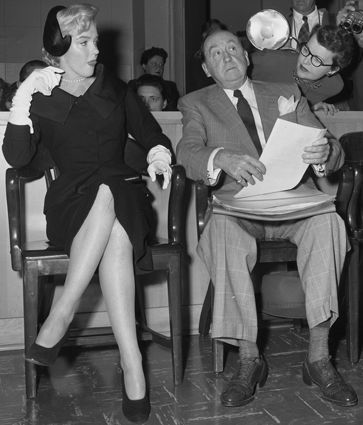 Divorce, new style. Marilyn Monroe sitting in a courtroom
Divorce, new style. Marilyn Monroe sitting in a courtroomwith her attorney while obtaining a divorce from Joe DiMaggio,
1954. But not in New York State. The wife is still garbed in black.
McCabe is obviously biased against divorce and those who either seek it or facilitate it, but sources from a later date show that there is substance in his account. So that’s how wealthy New Yorkers went about it in the early 1880s.
From the 1920s through the 1960s Reno, Nevada, the self-proclaimed “biggest little city in the world,” was known as the divorce capital of the U.S., because of Nevada’s minimal six-week residency requirement. By 1940, 49 out of every 1,000 divorces filed in the U.S. were filed in Nevada. And canny entrepreneurs established “divorce ranches” where divorce seekers could wait out the six-week residency requirement in ease. In Claire Booth Luce’s 1936 play The Women (later a 1939 film), most of her Park Avenue characters (all women, no men in the play or movie) end up on just such a ranch, with unexpected and hilarious results. Among the real people who got a Reno divorce were Mary Pickford, Cornelius Vanderbilt Jr., prizefighter Jack Dempsey, Rita Hayworth, heiress and socialite Gloria Vanderbilt, and others. And, needless to say, plenty of residents of New York City and State.
 Lómelinde
Lómelinde
Poster for the 1939 MGM movie. But how did Rosalind
Russell ever get demoted to smaller print? I saw it and,
young though I was, found it hilarious.
Not that Reno didn’t have competition. In 1960 Alabama granted 17,328 divorces, compared to a paltry 9,724 in Nevada. Other divorce mills were located in Havana, Paris, Mexico, and the (oh irony!) Virgin Islands. So the travel business was flourishing, thanks to travel-prone New Yorkers.
But what about those who were unable to decamp for distant regions? Annulments on various grounds were possible. But repeated attempts at divorce reform died in committee, so that in New York State adultery continued to be the only grounds allowed. Ah, but never underestimate the resourcefulness of New Yorkers. To establish adultery as grounds for divorce, a professional co-respondent was hired. In 1934 the New York Mirror published an interview with one Dorothy Jarvis entitled “I Was the Unknown Blonde in 100 New York Divorces.” In what came to be called “collusive divorces,” a husband and wife agreed to “stage” adultery. Of course the man must be at fault, not the virtuous wife. The husband and hired “mistress” take a hotel room, and when someone knocks on the door – presumably a maid or room service -- the husband or Blonde Bombshell (who could also be a Brunette Bombshell) answers the door scantily clad, and a photographer snaps a telltale shot or two and runs off, having obtained the evidence needed in court. But usually no hanky-panky has occurred; for the hired co-respondent, it’s just a job, for which she gets between $50 and $100, a nice little supplement to her income. These practices came to light again in 1948, when New York District Attorney Frank S. Hogan announced the arrest of ten members of a “divorce ring” on charges of perjury and subornation of perjury, thus confirming for the twentieth century McCabe’s revelations in the nineteenth. As a result, in 1949 the number of decrees in New York City dropped by a third. But divorce fraud soon revived and flourished.
Meaningful reform finally came with the Divorce Reform Law of 1966, which expanded the grounds for divorce beyond adultery to include:
· Abandonment for two years or more· Imprisonment of a spouse for over three years· Cruel and inhumane treatment· Living apart for two years or more pursuant to an agreement or a judicial separation decree
In exchange for supporting the bill, conservatives demanded and obtained safeguards against easy divorce. Filing procedures were made so complex that legal fees were beyond the reach of many, and elaborate counseling and conciliation procedures became mandatory.
 Jennifer Pahlka
Jennifer PahlkaDivorce proceedings could be long and costly and venomous. In 2005 Purpura vs. Purpura, a case that had dragged on for 21 years, finally seemed to be coming to an end. A Wall Street executive named Nicholas Purpura had been battling his wife over his assets since 1983, a fight initiated even before their divorce in 1988. He accused her of “humiliating and demeaning him” and calling him a “bozo” in front of their children, while she accused him of submitting phony bankruptcy records to keep her from getting his cash. A court ruling had finally decided that his $2.5 million, 17-room home on Staten Island was a marital property and therefore to be sold. But even that might not have been the end of it, since Purpura had filed four appeals that were still pending. Having spent more than $100,000 on six different divorce lawyers, the impoverished husband was now representing himself. “I won’t stop fighting,” he told the press, “even if I have to live in a pup tent.” So it goes in the world of the wealthy … or the once wealthy.
I can’t deny that we all get a certain perverse delight in reading accounts like Purpura’s of the marital woes of others, whose troubles seem far removed from ours. And in seeing photographs of erring couples caught in the act. Sometime back in those days Life magazine featured an article on a private detective hired to take telltale photos of erring couples in, I think, Berkeley, California. While his wife stood guard to warn him of interference, he stalked hotel corridors, knocked on doors, and snapped photos of whoever answered, or even invaded the room to take pictures. Life published a number of these photos, blacking out just enough of the facial features to prevent recognition. Like many a reader, I in my youthful ignorance gobbled up the photos in surprise and wonder. Some readers protested, as I recall, and when Life reported that the photographer’s wife was divorcing him (on what grounds? one wonders), it seemed grimly appropriate.
And here in New York State someone did a serious study of some 500 photos of adulterous couples used as evidence, listing how many men and how many women were in nightclothes, in their underwear, naked, or (a rather elegant touch) in a kimono. What the purpose of this was, I can’t imagine, though the results were published and are even available online. There’s a bit of voyeurism in us all, and New York’s strict divorce law encouraged it, and encouraged as well the invasion of privacy. A good example of how strict laws meant to encourage virtue and marital stability can backfire with dubious results.
Even as other states were adopting no-fault divorce laws, New York clung stubbornly to its fault-based laws. Until 2010, that is. And this in a state that is usually viewed as ardently liberal and progressive. So why the long delay? My guess: opposition to divorce reform by the Roman Catholic Church downstate, and by conservative Republican legislators upstate. And the reluctance of liberals to provoke a debate where they would be pilloried as enemies of marriage and the family. Though it has also been suggested that New Yorkers’ success in evading the state’s divorce law contributed, in that it lessened the pressure for reform. But no-fault divorce did come in time, though only after protracted and heated debate, when the contradiction between the laws on the books, and the actual practices of New Yorkers, could no longer be ignored. Yet the concept of fault still persists in the state’s political and moral traditions.
And today? If you google “New York divorce,” you will find such online offerings as these:
· New York Divorce -- $299· Uncontested Divorce -- $499· NY Divorce Online $149· Cheap New York Divorce· New York Divorce $79 $149
Yes, times have changed, and Reno is no longer the divorce capital of the country. New Yorkers can stay comfily put and get their divorces at what would seem to be bargain rates. “Money back guarantee,” says one ad, while another promises “no hidden fees,” and still another urges, “File in 1 day.” Obviously, it pays to shop around.
 A new twist, a law office sign in California.
A new twist, a law office sign in California.mandiberg
But how does the New York divorce rate compare with other states, and who has the highest rate, and who the lowest? According to the latest available government statistics, covering 2008-2009, the highest number of divorces per 1,000 people is – unsurprisingly – Nevada, with 6.6. The lowest rate is Massachusetts, with 1.8. And New York? In between, but on the low side: 2.5. And what states come close to Nevada? Surprises here, as well: Idaho and West Virginia, 5.0; Wyoming, 5.2; Arkansas, 5.6. Obviously, it’s not the liberal, permissive Northeast that tops the list, but more rural states where religion, including fundamentalism, still holds sway. Is there a connection? I’ll let the experts decide.
One last thought: Is there perhaps an alternative to divorce? In the village of Biertan, Romania, next to the old fortified church is a small, drab-looking building that seems to have no windows. For centuries, couples wanting a divorce have been obliged to reside there together for two weeks before proceeding with the divorce. Inside was only a single bed, plate, and spoon they had to share. This has been the custom for some four hundred years, and in all that time how many couples then chose to proceed with the divorce? Just one. Still, it’s worth noting that this is not a Roman Catholic or Orthodox community; it is Lutheran.
 The Biertan house for couples wanting a divorce. Not the latest in de luxe comfort.
The Biertan house for couples wanting a divorce. Not the latest in de luxe comfort.Alessio Damato
Two notes on trivia:
1. Last June, in a moment of delusion, I sent some poems to a small review. Recently, having heard nothing for six long months, I wrote the submission off. Then, on Christmas Day, I got an e-mail of rejection. The rejection doesn’t bother me, just the timing. What species of creep devotes part of Christmas Day to sending out rejections? My proposed response to the review: Merry Christmas right back at you! Pox vobiscum, and may you founder in insolvency in the coming year.
2. Chinese fortune cookies recycle clichés, but occasionally there is one of interest. Last Sunday, when my friend John and I lunched at our favorite local Chinese restaurant, he got this one:
Do onto others as you would have others do onto you.
Never has a fortune cookie been more suggestive.
Looking ahead to 2015:
Even the sedate and circumspect New York Times is willing to call “enhanced interrogation techniques” by their real name: torture. And torture is illegal by both American and international law. And that illustrious newspaper has even called for prosecution of all responsible, which at the very least would mean everyone from former Vice President Dick Cheney on down, including those who merely sanctioned it. Will this happen? I doubt it. At the most I anticipate denials, evasions, memory lapses, and legal obfuscations galore. Though maybe a court in Spain will do something, making travel there for some inadvisable. Perhaps, twenty or thirty years from now, something will happen, when all those responsible, having lived blithely and died gently, are safely in their graves.
 Ripe for dethroning?
Ripe for dethroning?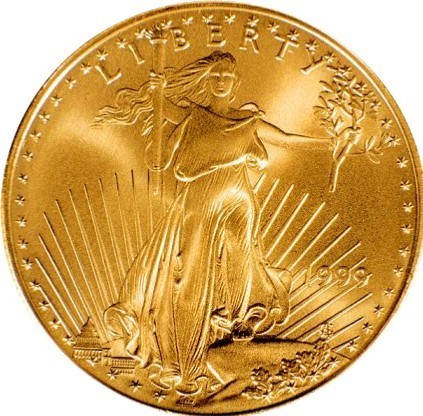 An American gold coin. Is this the answer?
An American gold coin. Is this the answer?WBAI takes delight in predicting gloom and doom, and its radio host and nutritionist Gary Null is no exception. Currently he predicts that in the near future the dollar will be dethroned as the safest and most reliable world currency, with resulting financial turbulence. Last Tuesday he had on his show a guest whose name I didn’t catch, but who agreed with Null and went even further, predicting that this will happen in 2015, provoking a crisis worse by far than the crisis of 2008. The dollar looks strong, he explained, only because all other currencies are weak; for him, the only safe asset is gold. So let’s see if he is right. Though no expert in finance, I know that, by historical standards, this bull market is long in the tooth and ripe for a severe correction, if not a full-fledged bear market, but beyond that I’m not prepared to go. So the unfolding year will let us see if these dire predictions have any substance or not. The U.S. recovery seems finally to be gathering strength, but bad news has a way of coming when least expected. Meanwhile, Happy New Year!
Coming soon: Forbidden Houses, including murderers’ homes and scenes of bloodshed, haunted houses, mystery houses, and houses of scandal. After that: Movie Theaters Then and Now: Palace, Sleaze, and Art.
© 2015 Clifford Browder
Published on January 04, 2015 04:55
December 28, 2014
159. Bookstores Used and Rare
Used-book stores used to cluster along what was called Book Row, the stretch of Fourth Avenue between East 9thand East 14th Streets in Manhattan, most of them small stores staffed by the proprietor and one or two friends who viewed their stores as more hobby than business, prompted by a love of books. The books were usually a jumble in no apparent order, obliging you to poke and poke about in hopes of finding something of interest. There were old prints too – usually from the nineteenth century – and on occasion I bought one. Somewhere I still have a picture of a dainty Victorian maiden celebrating May Day, so charming in its insipidity that I couldn’t resist. And once I was looking for a print of a Putnam County mansion belonging to Wall Street financier Daniel Drew’s son, which I wanted for an illustration for my biography of Drew, and -- wonder of wonders! – I found it at the Pageant Book and Print Shop.
The proprietor of the Pageant came to know my interest in nineteenth-century New York and, the moment I entered, pointed me to the relevant counters and bins. Also from Pageant, and added to the “clothing” folder in my file of background material for my historical fiction, were two French fashion prints, one from the Journal des Demoiselles showing two supremely elegant young women in voluminous hoopskirts, and the other from Les Modes Parisiennes showing two more young ladies in elaborately decorated hoops. Never was the female form adorned so lavishly and hidden so amply. And of course there were the items I should have bought and didn’t, to my later vast regret, as for instance, also at Pageant, a dictionary of Homeric Greek. Later, when I undertook to read Homer in the original (yes, I actually did!), it would have helped me hugely; without it, I had to poke through my lexicon of Greek to find the Homeric terms, which was frustrating and time-consuming.
 Le Journal des Demoiselles, 1857. Voluminous skirts, lacy finery, faces blandly identical.
Le Journal des Demoiselles, 1857. Voluminous skirts, lacy finery, faces blandly identical.But the day of the Fourth Avenue bookstores is long since gone. From the 1960s on, one by one they were forced out by rising rents, as the neighborhood was invaded by antique warehouses, art supply stores, and pricey coop apartments. And forced out as well by mortality, as the aging dealers retired or died off. But the old Pageant, my favorite, has survived; in 1999 it went virtual and is now housed in a website sponsored by the daughters of one of the original founders. They boast of offering worldwide access to items formerly found by patient book and print seekers crawling up ten-foot ladders or sprawling on dusty floors flipping through drawers and boxes. True enough, but the crawling and sprawling were part of the adventure of the old stores.










In 1957 one of the old Fourth Avenue bookstores moved to another location and is a thriving enterprise today: the Strand Bookstore at Broadway and East 12th Street, which, founded in 1927 and run successively by three generations of the same family, claims to have 18 miles of new, used, and rare books, some on site and some in a warehouse. No cozy little bookstore, this, but a modern enterprise with over 240 unionized employees and 2.5 million books on every conceivable subject, plus an array of gifts including coffee mugs, calendars, tote bags, souvenirs, and gift cards virtual and real. And you don’t have to come to the store, since you can shop online. As for rent increases, no problem: it owns the building.
 Beyond My Ken
Beyond My KenI’ve often browsed there in the past, glancing at the outdoor stands of cheapies before pressing in to explore the tables and floor-to-ceiling shelves of books on three floors: fiction old and new, comic books, cookbooks, travel books, art books, science books, biographies and memoirs, rare and unrare books, bestsellers, children’s books, staff picks, recent arrivals and dusty old classics. And a public restroom. On the wall today, so the website indicates, is a sign: “IF YOU GO HOME WITH SOMEBODY, & THEY DON’T HAVE BOOKS, DON’T F**CK ’EM.” And they even hold weddings there: two confessed book nerds report online that it was the wedding of their dreams. Most of the online reviews are raves, with one recent negative: “Horrible. I went in there today and I was kicked out without being told why.” There’s a story there, but who knows what it is. In the reviews two small negatives recur: the store tends to be crowded, and there aren’t many places to sit. My own experience there is, at best, mixed; more of that anon.
 The Strand basement.
The Strand basement.The Strand is a super modern enterprise and as such has survived. But in this huge, sprawling city are there no small independent used-book stores such as those once found on Fourth Avenue? Yes, but they aren’t clustered together. You’ll find them at scattered locations especially on the Lower East Side of Manhattan and in Brooklyn. The reviews of these places praise the books to the skies, and savor the atmosphere of books crammed in all over the place, so that even in this age of chain stores and the Internet, you can see, touch, and smell old books. Some patrons complain of the utter disorganization of some of the stores, but others enjoy the serendipity effect, not knowing what buried treasure they may find. Here, if anywhere, you can experience again the rich clutter of the old Fourth Avenue stores.
But there is a catch: while some reviews praise the staff, others are resentful and caustic. Consider these selections from online Yelp reviews of Spoonbill & Sugartown in Brooklyn, East Village Books and Mast Books on the Lower East Side, and Westsider Rare and Used Books on the Upper West Side.
Stood for almost two minutes in front of the girl at the cashier who was NOT in the mood to help me find a book. In short, great store for browsing but don't expect any service here. They lost my patronage.
The woman working behind the counter should stick to working with books and not with people. The moment I walked in, I felt as though she was convinced I was going to steal something. When I explained I was looking for something by Baurdrillard [Baudrillard], she corrected my pronunciation. I know how to speak French, bitch, but I'm not in France, I'm in Brooklyn: so cut me some slack. Not that she had any books by him in stock, anyway, so a simple "no" would have sufficed…. Despite the mothball stuffed biddy behind the counter, this bookstore had a really great selection of harder to find books: new, used, first editions, etc.
The guy working here was incredibly and unnecessarily rude to us. They have a nice selection of books, but we walked away on principle. If I could give it zero I would, but one star for the cat.
Sometimes, the bored ex-hippie working the register is super helpful, and sometimes it's the bored current-hipster who doesn't like that you're interrupting his “inspiration time.”
Staff is sullen and unhelpful…. Books listed via their Amazon site are nowhere to be found. And better yet, their staff have no clue about that -- they're too busy surfing the web ... or something. I've been to many used bookstores in many places. This is the only one I would make a point of avoiding.
Completely inattentive employees--which seems to be the standard for NY establishments, in my experience--no greeting, no asking if I needed help, no "good-bye." The one guy I saw working literally never looked up from his computer the entire time I came in. Crappy/non-existent customer service aside the store is totally disorganized.
I came by to sell back some books about New York City history that I had. The man who worked there ignored me for about 5 minutes, and finally I got him to help out. He only wanted one of the books, one that was brand new and I probably paid $20 for originally. He took forever to look at them and then offered me $1. Even though I shouldn't have, I gave him the book because he was so weird and creepy that I just wanted to get out of there. I never leave reviews for places, but there was a hand-written note on the door asking customers to write a review on Yelp. So here's your review, jerk!
Today I bought a few books and I thought I was going to have to get the paddles on the guy who was working there, jump-start his heart. But at least he charged me correctly.
I typically have good experiences in this store, but I just left and am still feeling shaken up by the way I was treated by the saleswoman. From the moment my friend and I walked in, she told us she couldn't help us find what we were looking for several times, and similarly told other customers in a rude tone of voice that she couldn't help them, couldn't take large bills, didn't know where anything was located, etc. After she rang up my purchase, I presented a 30% off coupon and she scoffed at me and condescendingly said, "Seriously?! You can't pay $4.36?!" When I smiled and told her that every penny counts, she said, "Yeah, for us too," rolled her eyes, and muttered expletives under her breath about me. I will have to be desperate to return here.
To his credit, the owner of Westsider Rare and Used Books reads the reviews and sometimes comments on both positive and negative ones. Responding to one negative one, he noted that many of the negative reviews were from disgruntled people trying to sell books that Westsider simply can’t use. He also conceded that he and his staff, assailed constantly by would-be sellers, can be brusque, and understands the frustration of someone lugging books all the way across town only to have them rejected. Finally, he pledged to be gentler with sellers from now on. All of which may explain a lot of the unpleasant interactions in all the stores. And to be fair, his store gets more positive than negative reviews.
And now I’ll add my two cents about the legendary Strand. Though it garners good reviews, I have to take exception regarding the staff. I have bought and sold books there over the years, but only once in all that time did anyone thank me. One young squirt had to be persuaded that it was acceptable to give a receipt for a sale, and then did so with thinly veiled hostility. And the book buyers have always been joyless and soulless automatons, spitting out prices for the books without a trace of human feeling. Worse still, one once suggested that I was trying to sell him one of Strand’s own books that I had just snatched from the shelves. By calling to witness the guard at the entrance, who saw me come in with the book, I proved him wrong, but did the creep then apologize? No, he just bought the book. This was a while back, so maybe things are better today. At least, they now have a separate entrance for anyone wanting to sell them a book, which might eliminate the problem I encountered.
One bookstore that gets mostly rave reviews is Argosy Books at 116 East 59th Street on the Upper East Side of Manhattan. Founded in 1925 (two years before the Strand) and now, like the Strand, in its third generation of family ownership, it has a six-floor building in midtown and a large warehouse in Brooklyn. Even older than the Strand, Argosy specializes in old and rare books, prints, and maps, and therefore differs from the Strand, which offers a much wider selection.
Argosy also offers “books by the foot” for interior decorators, architects, model homes, TV and theater sets, and individuals in need of an instant library. Their price for this item? $30 and up per foot for cloth-bound books, and $250 and up for antique leather. So for folks who want books around for atmosphere but can’t be bothered to read them, here is the solution.
Yet even Argosy gets an occasional bad review triggered not by the books but the staff, as for instance:
Have dealt with them in the past and my family has bought many books from them. I called to get a second opinion on a first edition book we had an offer from Baumann Rare Books on, when I mentioned that to the older woman buyer she said that "We wouldn't be interested then." This is the second time I have spoken with her over the phone, she is very rude and condescending. I will never deal with them again!
With old rare books outside my price range and huffy and reluctantly helpful middle aged female staff, Argosy boasts the rude personnel, narrowish shelves, old New Yorkers browsing, and stuffy book smell of a true New York bookstore.
If there's anything off-putting about Argosy it might be the indifference of the people working there, but that's part of the experience. You don't go to a place like this for customer service, you come here to dream, gamble, and lose yourself. What treasures you find depend on the amount of digging you're willing to do.
In fairness to all the stores, I’ll grant that everyone has good days and bad. And since there are some positive reviews about staff as well, maybe it depends on who you happen to encounter. And my one contact with Argosy, when they turned down an e-mail offer of three rare books, was not unpleasant; their reply, in fact, was courteous and considerate. But the negative reviews of all the stores show real verve and spirit, and also prove that even in the age of ubiquitous chain stores and the Internet, there are readers who are happy browsing in little independent stores by the minute or the hour.
And who exactly are these browsers, who come in to kill time or take shelter from the rain, or to look for some hard-to-find item, or simply for the fun of poking about among acres of old books? Bookworms, no doubt, like myself. From an early age I had my nose in a book, while other boys were out scrimmaging in vacant lots, or indulging in the raucous jubilance of baseball. And for that preference – or should I say obsession? – I paid a heavy price, since the oddball reaps insults and scorn. But we persist, we bookworms, and find our refuge, our fulfillment, our paradise in those grubby little stores crammed with musty, dusty books.
And of course we end up with too many books: shelves and shelves of them, and sometimes boxes and bins as well, and even that last resort, the oven. No, I and my partner Bob haven’t appropriated the oven, but we are so overloaded with books that we’ve agreed to sell some 250 to 300 of them, which will still leave us with hundreds more. And to whom will we sell them? To the used-book stores, if they're interested (so far, they aren't). And what they don’t take, we’ll donate.
Bookstores like Argosy that specialize in rare books constitute a category all their own, and the king of the trade in New York is surely Bauman Rare Books at 535 Madison Avenue, with branches in Philadelphia and (do people really read there?) Las Vegas. Founded in 1973 by Natalie and David Bauman, the store offers highly personalized service by experienced professionals, and over 4,000 books, maps, and prints from the fifteenth through the twentieth centuries, all of them thoroughly researched, so that collectors can purchase with confidence. Their website photographs show a spacious, elegantly appointed interior with dark wood-panel walls and shelves housing beautifully bound old books behind glass – a striking contrast with the cluttered little bookstores mentioned earlier. And among the offerings are first editions of Chaucer or a Shakespeare folio. I contacted them once about three rare books I wanted to sell – the same three I offered to Argosy, and admittedly a long shot. The books weren’t right for them, but they answered in a courteous and helpful letter, suggesting where I might learn the books' current value and sell them. The gentleman – or gentlewoman – of the trade.
One might assume you don’t go to Bauman just to browse, unless ready to spend a small fortune on books, which is why, to date, I have never set foot on the premises. But the online reviews prove me wrong, for book lovers of modest means tell of visiting Bauman’s hushed interior the way one goes to a museum, and even having the glass doors unlocked so they can touch the treasures within, while being well received by a friendly and well-informed staff. Still, I’m not tempted; my focus has always been on a book’s content, not its packaging – that is, not on the binding, the date, the edition, and all the other things that make a book rare or unique. I want a book to be an old friend that I can handle with ease, not a treasure to be enshrined on a shelf and rarely touched.
 Beautiful to look at, but I wouldn't buy.
Beautiful to look at, but I wouldn't buy. You never know what you may find inside an old binding.
You never know what you may find inside an old binding.Toufik-de-planoise
Finally I’ll mention another store that I just discovered in my neighborhood: Left Bank Books at 17 Eighth Avenue, a short ten-minute walk from my apartment. It specializes in hardcover literary first editions, especially fiction, poetry, drama, and literary nonfiction, but offers quality used books, mostly hardcover, on many subjects, in what one reviewer calls “an organized sprawl.” Why first editions? Because, the owner explains, they give you a feeling of being there when the book was new. It’s a small store where four or five people browsing are almost the limit, but a chair in back offers refuge to a browser with time to kill. You don’t get the musty smell of old books so beloved of bibliophiles, since the books tend to be of fairly recent vintage, but there are treasures to discover. Often seated near the entrance is the owner, Kim Herzinger, who fields queries and buys books in a courteous and knowledgeable way, and with a sense of humor. Thanks to him, I suspect, Left Bank Books gets uniformly good Yelp reviews, in contrast to so many of other stores where the staff leaves much to be desired. I have browsed there recently and sold him two books, and hope to be back soon, delighted to find such a store within easy walking distance.
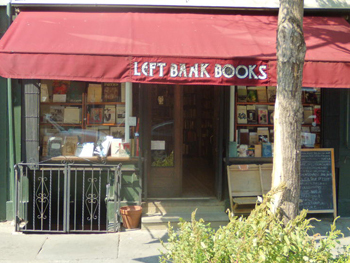 Left Bank Books
Left Bank Books
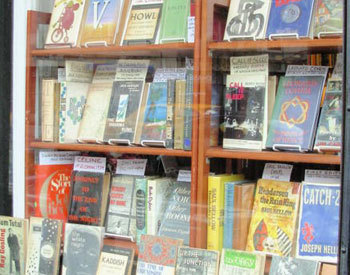
 Cozy, but crowded.
Cozy, but crowded.Left Bank Books
Note on me and WNYC: The holiday season is a time for giving ... and for soliciting givers. As viewers of this blog know, in my modest way I help support two listener-supported local radio stations, WBAI and WNYC. WBAI is in the throes of yet another financial crisis and, as a result, is constantly changing its programs, for better and for worse. When in need of calm and stability, I take refuge with WNYC. But when their most recent plea for donations came, it occurred to me to ask if they take money from Monsanto or Goldman Sachs, two outfits I don't approve of. So far, no response. And therefore, so far, no donation. So it goes in the world of nonprofits.
Coming soon: Divorce, New York style.
© 2014 Clifford Browder
Published on December 28, 2014 04:54
December 21, 2014
158. Goldman Sachs: Vampire Squid or Martyred Innocent?
“It’s everywhere. The world’s most powerful investment bank is a great vampire squid wrapped around the face of humanity, relentlessly jamming its blood funnel into anything that smells like money.”
 A vampire squid.
A vampire squid.Citron/CC-BY-SA-3.0
 Mouth of a vampire squid.
Mouth of a vampire squid.So wrote journalist Matt Taibbi in a memorable article of July 9, 2009, in Rolling Stone magazine, presenting an image that resonated then and still resonates. His target was the multinational investment banking firm Goldman Sachs, now headquartered in a soaring 44-story tower at 200 West Street in Lower Manhattan. Certainly this ultra-modern edifice proclaims its occupant a major player in the global world of finance, and one not to be trifled with. So why has it inspired such venom? I know nothing of vampire squids, but I’m sure I wouldn’t care to meet one. And why, when I utter the words “Goldman Sachs” to friends and acquaintances unversed in the world of finance, do they reply with phrases like “big investment firm … dubious practices … cheating”? What’s the story with this alleged blood-sucking predator? Does it really merit such censure? Bear with me as I, a layman with no special knowledge of finance, poke into the story and try to find some inklings of the truth.
 The Goldman Sachs Tower at 200 West Street.
The Goldman Sachs Tower at 200 West Street.Beyond My Ken
First, a little history. Who was Goldman and who was Sachs? The firm was founded by Marcus Goldman, a Jewish German immigrant from Bavaria who began as a peddler with a horse-drawn cart in Philadelphia, became a shopkeeper, and later removed to New York, where in 1869 he opened an office dealing in IOUs. (If you don't quite grasp that, neither do I, but it sure paid off.) In 1882 his son-in-law Samuel Sachs joined the firm, which from then on was known as Goldman Sachs. The firm prospered, turning over $30 million in commercial paper a year, and in 1896 joined the New York Stock Exchange. No longer controlled by the Goldman family, in the twentieth century the firm survived the 1929 crash and became involved in investment banking as well as trading. Today its stock is publicly traded, much of it owned by institutions like pension funds and banks. It has a global presence, and its former employees have served on the White House staff and headed the New York Stock Exchange, the World Bank, the U.S. Treasury Department, the New York Federal Reserve, Citigroup, and Merrill Lynch. Rare is the financial pie it doesn’t have its finger in. So it is indeed everywhere, but is it a vampire squid?

For me, in the 1990s the face of Goldman Sachs was that of Abby Joseph Cohen, the firm’s chief investment strategist, who often appeared with one or two other women in the semiannual Barron’s roundtables, where a dozen or so financial experts were assembled to forecast the near-term developments of the economy and the markets. (Yes, in those days I was actually reading, or at least scanning, Barron’s.) Abby had reaped renown by predicting the bull market of the 1990s, and there was something about her that won you over. New York-born, she looked unpretentious in photos, nothing glitzy, little or no jewelry, her hair short, with the warmest smile: a Jewish momma from Queens who had made good in the hard-slugging male world of finance. You simply wanted to believe her and wish her well. And she was indeed a momma, having two teen-age daughters. You couldn’t imagine her arriving at the office in a chauffeured limousine (though maybe she did), or jetting about the world to attend exclusive financial gatherings or advise clients (though in fact she did). Abby was one of us.
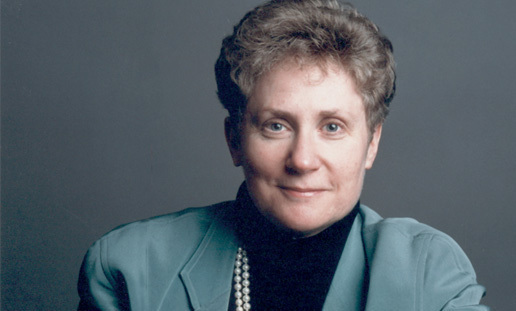 Abby Joseph Cohen
Abby Joseph CohenSo influential was she in the 1990s that when a rumor hit Wall street in 1996 that she was switching from bull to bear, the Dow Jones Industrial Average plunged 60 points; then, when she got on the firm’s worldwide communications system to refute the rumor, it bounced back up again. Power was hers.
Alas, like many other experts, Abby failed to predict the brutal bear market of 2000 and was ridiculed for her persistent bullishness as stocks plummeted. Worse still, again like most experts, she failed to foresee the brutal bear market of 2008, and in March of that year was replaced as Goldman Sachs’s chief forecaster. And today? As Goldman Sachs’s senior investment strategist, she still appears in Barron’s roundtables and – you guessed it – she is resolutely bullish. And so far she’s been right.
In the 2007-2008 mortgage crisis that caught so many investment firms by surprise, Goldman Sachs sold subprime mortgage-backed securities short, so while other outfits faced catastrophic losses, it was reaping billions in profit. In my eyes, nothing wrong with that; it was just smarter than the rest of the boys. (No gender bias intended; this was a boys’ game primarily.) No wonder the New York Times proclaimed Goldman Sachs without a peer in the world of finance.
But then the picture darkened. In October 2007 a Fortune magazine senior editor noted that Goldman Sachs had sold a $494 million issue backed by risky second-mortgage loans, the very kind of transaction that had facilitated the housing bubble, and the resulting bust that triggered the financial crisis then under way. Was Goldman Sachs too shrewd for its own good? Not in this instance. Many borrowers defaulted on these junk mortgage loans, and investors who bought the issue suffered heavy losses, but not Goldman Sachs, since it had shorted the junk mortgage market, betting that prices would drop.

Even so, Goldman Sachs was not immune as the financial crisis developed. Chaos followed when Lehman Brothers went into bankruptcy, triggering panic throughout the world. Then in September 2008 Goldman Sachs became a traditional bank holding company, ending the era of wild investment banking on Wall Street. Why did it do this? To get aboard the federal gravy train, of course. The change in its status meant that it would henceforth be regulated by the Federal Reserve, so that it qualified for a $10 million investment from the U.S. Treasury as part of the Troubled Asset Relief Program (TARP), a government program to purchase assets from troubled financial institutions in hopes of stabilizing a very shaky financial system. In other words, the government used taxpayers’ money to bail out Goldman Sachs and other big financial institutions endangered by their risky speculative investments. Big Brother was rescuing the bad boys when their misdeeds came home to roost. (Pardon the inept image.) To be sure, the firm repaid the Treasury’s TARP investment with 23% interest in June 2009, so the government was not suckered in the deal.
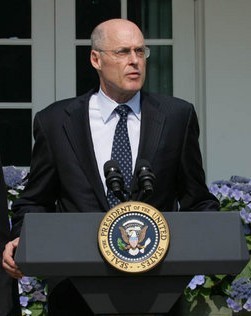 Henry M. Paulson, Jr. And who was Treasury Secretary during all these tumultuous events? Henry M. Paulson, Jr., a former Goldman Sachs CEO. And who were his assistants at Treasury? A clutch of other Goldman alumni, all of them talented, but still, it makes one wonder. Goldman insisted that, in a time of dire crisis, they were serving their country by making their expertise available in Washington. Though unaware that patriotism raged on Wall Street, I’ll grant that in this assertion there may be a grain, a tiny grain, of truth. And in Washington one makes so many useful contacts…
Henry M. Paulson, Jr. And who was Treasury Secretary during all these tumultuous events? Henry M. Paulson, Jr., a former Goldman Sachs CEO. And who were his assistants at Treasury? A clutch of other Goldman alumni, all of them talented, but still, it makes one wonder. Goldman insisted that, in a time of dire crisis, they were serving their country by making their expertise available in Washington. Though unaware that patriotism raged on Wall Street, I’ll grant that in this assertion there may be a grain, a tiny grain, of truth. And in Washington one makes so many useful contacts…These complicated financial doings can only baffle the layman. Is Goldman Sachs a good guy or a bad guy? If only it were that simple. To even have a clue, you have to understand at least a little what these complex financial transactions involved. Here is what this layman has grasped. Derivatives, it should be noted, are contracts deriving their value from some underlying entity such as an index or an interest rate or an asset, in this case subprime mortgages (sometimes endearingly termed “junk mortgages”).
1. Back in 2000 Congress, in its infinite wisdom, passed something called the Commodities Futures Modernization Act, which, inserted at the last minute into an 11,000-page spending bill with almost no debate, “modernized” derivatives trading by freeing it from most existing federal regulations. In this shadowy sector of the market, then, banks like Goldman Sachs were free to do as they wanted.2. Eager home buyers were encouraged to take out a mortgage, even though their shaky finances made it unlikely that they could make the periodic payments required.3. These subprime mortgages were bundled into packages of risky mortgage-backed securities (a form of derivative) and sold by Goldman Sachs and other banks to unsuspecting pension funds and insurance companies.4. Even as it was doing this, Goldman Sachs was betting that the value of these mortgage-backed securities would decline, which it did.5. The buyers of these securities suffered a whopping big loss.6. Goldman Sachs raked in a whopping big profit.7. Meanwhile lots of homeowners were defaulting on their mortgage payments and facing foreclosure, meaning they would lose their homes.
 The enticement: a subprime mortgage offering, 2008. But God help those who were enticed.
The enticement: a subprime mortgage offering, 2008. But God help those who were enticed.The Truth About What is one to make of all this? The home buyers acted unwisely, but they were encouraged to do so, and all they wanted was to own their own home. The buyers of the securities failed to do their homework, didn’t grasp how risky their investment was; they paid the price of their negligence. Goldman Sachs, by selling risky securities that it wanted to see decline in value, may or may not have been committing securities fraud (it depends on who you talk to), but this was hardly ethical. And why were these risky securities, backed by junk mortgages, on the market anyway? Because too much money was looking for too few investments; in the absence of sound investments, investors were offered junk, which they eagerly snapped up. Permeating the whole scene was ignorance on the part of some, and feverish greed and wild speculation on the part of others – a formula for disaster. And disaster came.

If you’re still baffled by all this, don’t be concerned. These are complex and esoteric financial matters best understood only by seasoned traders and analysts, which makes these markets just that much harder to regulate. Laymen could just ignore the whole shebang, except that this unregulated market provoked a financial crisis that engulfed us all, and whose repercussions are still being felt. Ask anyone who can’t find a job, or has to hold two or three jobs to support themselves, or is about to lose their home through foreclosure, or has lost it already.
It is interesting to note that, in the crisis year of 2008, Goldman Sachs paid $14 million in taxes. Does that sound like a lot? Its profit that year was $2.3 billion, and in 2009 it paid its CEO $42.9 million. But how could it pay a mere 1% in taxes? Because it shifted its earnings to subsidiaries in low-tax or no-tax countries, a manipulation beloved of multinational corporations and quite legal; it had 15 subsidiaries in the Cayman Islands alone. Said one Democratic Representative from Texas, “With the right hand out begging for bailout money, the left is hiding it offshore.” Ah, clever Goldman, it doesn’t miss a trick.
Other matters worthy of note:
· To settle a lawsuit by the SEC alleging securities fraud linked to mortgage investments, in 2010 Goldman agreed to pay $550 million.· In 2009, in the midst of the financial crisis, it set aside $11.4 billion for employee bonuses.· In 2010 it came to light that a Goldman director had tipped off a hedge-fund manager about a substantial investment in Goldman by the legendary investor Warren Buffett before news of the investment reached the public, which amounted to illegal insider information.· Goldman has been accused of helping the Greek government hide the size of its debt from 1998 to 2009.· In 2011 the Washington Examiner reported that Goldman was the company that raised the most money for Obama in 2008, and that its CEO had visited the White House ten times.· After ex-director Stephen Friedman became chairman of the Federal Reserve Bank of New York, which regulated Goldman, he held on to his Goldman stock and bought more, prompting charges of conflict of interest that led to his resignation in 2009.· In 2009 Goldman agreed to pay up to $60 million to end an investigation by the Massachusetts attorney general into its involvement in alleged predatory mortgage lending practices.· In 2010 the SEC charged Goldman and one of its vice presidents with securities fraud, leading to a settlement in which Goldman paid $550 million.

And so on and so on. More potentially damning, in 2012 Greg Smith, the former head of the Goldman Sachs equity derivatives business in Europe, the Middle East, and Africa, resigned his position, saying in a letter made public in the New York Times that Goldman had a “toxic and destructive” environment in which “the interests of the client continue to be sidelined.” This caused quite a stir, even though his account was found to be wanting in specific details.
On the positive side:
· The Goldman Sachs Foundation has given $114 million in grants to promote youth education worldwide.· Goldman has been on Fortune magazine’s 100 Best Companies to Work For list since 1998, with emphasis on its support for employee philanthropy.· In 2008 it initiated the 10,000 Women program to train women from developing countries in business and management.· In 2008 it pledged $500 million to help small businesses in business and management education and philanthropy.· In 2012 it offered a loan of $9.6 million to deliver therapeutic services to teenage inmates on Rikers Island.
And so on and so on.
So is Goldman Sachs a great vampire squid, as alleged in the Rolling Stone article? How is a layman to say? But a Forbes magazine article of August 8, 2013, entitled “The Great Vampire Squid Keeps on Sucking” said the following:
Goldman Sachs, the vampire squid, and its Wall Street cohorts see money everywhere. They will attempt to squeeze a deal even if it’s not a banking project. Like street thugs, Wall Street banks are manipulating prices, such as aluminum, to profit. The result is higher prices for consumers.
If even the financial press condemns Goldman Sachs, the basic charges of the Rolling Stone article would seem to be confirmed.

Does Goldman Sachs then supplant Monsanto as the company I most love to hate? No, because it poses no immediate threat to me, whereas Monsanto tampers with the very food I eat. Also, to understand such tampering requires grasping only a term or two such as “bovine growth hormone” and “genetically modified organism” or “GMO,” whereas getting a fix on Goldman Sachs’s shenanigans requires mastering a whole battery of esoteric terms:
· Derivative· Mortgage-backed security· Credit default swap· Collateralized debt obligation· Hedging· Arbitrage· Option
When these and other terms burst upon the public consciousness with the financial convulsion of 2008-2009, many on Wall Street confessed that some of these terms baffled even them.
 Monsanto
MonsantoAh, how one misses those simpler days of the 1990s, when a bull market was raging, and Abby Joseph Cohen, unpretentious and benign, presented the face of Goldman Sachs! And what of Abby today? In a 2011 interview with Deborah Solomon of the New York Times, she sidestepped some pointed questions about Goldman Sachs or gave rather vague answers. Asked if it was ethically justifiable for some bankers to earn $50 or $60 million a year, when unemployment was nearly 10% and income inequality was widening, she noted that such inequality was apparent in many sectors and mentioned athletes, entertainers, and chief executives. And when asked if she felt any responsibility for the economic meltdown of 2008, she said that the causes were multiple and mentioned “bad decisions made by many different entities.”
Clearly, through thick and thin, Abby is loyal to her firm. And how is that firm doing today? In October of this year it reported net earnings of $2.24 billion (yes, billion, not million) for the third quarter of 2014, with assets under supervision increasing to a record $1.15 trillion (yes, trillion, not billion). If vampire squid it is, it is getting on swimmingly.
The New York Times of December 11, 2014, reported the results of a recent poll asking opinions on a wide range of economic and financial issues. Among the questions and answers were these:
How much confidence do you have in Wall Street bankers and brokers?· A lot, 4%· Some, 31%· Not much, 29%· None, 32%
How much confidence do you have in the federal government’s ability to regulate financial institutions?· A lot, 9%· Some, 31%· Not much, 34%· None, 24%
If any further confirmation were needed, as a part of the compromise to keep the government running, on December 11, 2014, the House of Representatives voted to loosen the regulations for derivatives trading. The gravy train rolls on.

But that’s still not the end of it. On December 12 Senator Elizabeth Warren of Massachusetts took the Senate floor to excoriate Citigroup for its exerting undue influence on federal legislation, and its work to loosen rules on risky derivatives trading, while noting how many Citigroup alumni hold significant posts in the federal government. It was a heartfelt speech such as I have rarely heard a politician make, and thanks to WBAI I heard the heart of it. She bitterly opposed the Senate’s following the House in voting to loosen derivatives regulation, which it then proceeded to do. Her chief target was Citigroup, but Goldman Sachs could have been substituted and all her charges would have stood. The speech has been hailed by many as electrifying and historic, and The Huffington Post calls it the speech that could make Warren the next President of the United States. That’s going some, but I agree that it was historic.
And there’s still more. In the Times Business section of December 14, 2014, veteran financial journalist Gretchen Morgenson reported, under the caption At Big Banks, A Lesson Not Learned, that the government has fined ten big financial firms, Goldman Sachs among them, $43.5 million for violating regulations in 2010. And many of the firms involved had been fined a total of $1.4 billion for violations back in 2003. Yes indeed, a lesson not learned. Even a layman like myself can see that Goldman Sachs, Citigroup, and our other big banks are still engaging in risky deals that sooner or later are bound to provoke a crisis, at which point they will expect us, the taxpayers, to bail them out once again. To learn better, they will have to be kicked in the teeth. And so, I’m afraid, will all of us, until we march in the streets, banging pots and pans or whatever, so as to make Congress impose penalties that cut the offending banks to the quick. That day, I hope, will come. I don’t know when, but it will, it must.
Final thought: Big financial institutions like Goldman Sachs have money and connections and power. What they don’t have is respect.

Dick Cheney, the man I love to hate: In a previous post (#82, “Who makes money when America goes to war?”) I noted why ex-Vice President Dick Cheney had much to smile about. Now he has resurfaced (though he never really went away) in the wake of the Senate report on the CIA’s use of torture, a use that, as Vice President under Bush #2 (Baby Bush, as opposed to Papa Bush), Cheney vigorously supported at the time. “I would do it again in a minute,” he announced in an NBC “Meet the Press” TV interview. Yes, even if it involved holding a prisoner in a coffin-sized box for 11 days, or handcuffing a prisoner’s wrists to an overhead bar for 22 hours a day. As for “rectal feeding,” he believes it was done for medical reasons. His views on the subject differ radically from those of fellow Republican John McCain, who was tortured while a prisoner of the North Vietnamese. Mr. Cheney did not serve in the Vietnam War, having received four deferments as a student and a fifth as a new father. He is now 73 and has had a heart transplant, though the new heart seems to be working much like the old one. Baby Bush has had the good grace to admit a few mistakes (the Mission Accomplished show, his ill-timed “Bring ’em on” remark, so resented by U.S. soldiers in Iraq), but his no. 2 is fiercely consistent. Often photographed as V.P. smiling against a backdrop of the Stars and Stripes, Dick Cheney is fast becoming the man I love to hate.
 What a winning smile! And a flag on his lapel as well.
What a winning smile! And a flag on his lapel as well.A note to Anonymous: A viewer of this blog who calls himself (I assume it’s a “him”) Anonymous has added two fervent comments in response to my post on David Rockefeller (#89, Sept. 29, 2013). He thinks me naïve, and I find his tirades, while interesting, intemperate and extreme. We aren’t diametrically opposed; it’s a matter of degree. I give the Rockefellers the benefit of a doubt, given their generosity in creating Rockefeller Center in the pit of the Depression, and their help in founding the Museum of Modern Art, whereas Anonymous denounces them with what strikes me as visceral hate. So I now ask Anonymous, not to refrain from his comments (which are always welcome), but to stop masking himself with anonymity. Have the guts to drop the name “Anonymous” and make your case under your own name. If you do, your comments will have more weight with both me and others.
Coming soon: Used and rare-book bookstores, who patronize them, and why do they denounce the employees? And what am I to do with 250-300 used books I need to get rid of? And after that, maybe divorce New York style, from way back down to today. (It wasn’t always easy; you had to fake adultery.)
© 2014 Clifford Browder
Published on December 21, 2014 05:09
December 14, 2014
157. Taxes: Who Pays Them and Who Doesn't
 No subject can raise more hackles than taxes, including above all income taxes. Long ago in Alaska, before that territory had become a state, a resident urged me to urge my Congressmen to endorse statehood for Alaska. And if that meant more taxes, so be it. “You can’t have civilization without taxes,” he insisted. This is not an opinion shared universally. In our Western states, especially, citizens are wary of government, convinced that the IRS is out to grab their hard-earned cash and give little in return for it. But tax avoidance, so common in many foreign countries, is not sanctioned here. Back in the 1950s, when I was hanging out at the San Remo bar in the West Village, I overheard snatches of conversation from two Frenchmen, one new to the States and the other his mentor, who were watching “les existentialistes américains,” a scruffy bunch of bohemians imbibing at the bar. But the Frenchmen were discussing other matters. Said the veteran to his newly arrived friend, “En Amérique la taxe est sacrée” (In America taxes are sacred).
No subject can raise more hackles than taxes, including above all income taxes. Long ago in Alaska, before that territory had become a state, a resident urged me to urge my Congressmen to endorse statehood for Alaska. And if that meant more taxes, so be it. “You can’t have civilization without taxes,” he insisted. This is not an opinion shared universally. In our Western states, especially, citizens are wary of government, convinced that the IRS is out to grab their hard-earned cash and give little in return for it. But tax avoidance, so common in many foreign countries, is not sanctioned here. Back in the 1950s, when I was hanging out at the San Remo bar in the West Village, I overheard snatches of conversation from two Frenchmen, one new to the States and the other his mentor, who were watching “les existentialistes américains,” a scruffy bunch of bohemians imbibing at the bar. But the Frenchmen were discussing other matters. Said the veteran to his newly arrived friend, “En Amérique la taxe est sacrée” (In America taxes are sacred).  New York is a notoriously high-tax state, and residents of New York City are hit with a triple whammy: federal income tax, state income tax, and yes, believe it or not, a city income tax. The state income tax alone is grounds for complaint. In the 1970s, when I was doing research in Putnam County, I observed that if two New York City residents got together, they talked about crime, whereas when two Putnam County people got together, they talked about taxes. And dodging the state tax was not unheard of. From a friend who taught there, I learned that some of the professors at Skidmore College in Saratoga listed a summer residence in Vermont as their main address, so as to escape the New York State income tax. Whether the state ever got wise to this, I have no idea.
New York is a notoriously high-tax state, and residents of New York City are hit with a triple whammy: federal income tax, state income tax, and yes, believe it or not, a city income tax. The state income tax alone is grounds for complaint. In the 1970s, when I was doing research in Putnam County, I observed that if two New York City residents got together, they talked about crime, whereas when two Putnam County people got together, they talked about taxes. And dodging the state tax was not unheard of. From a friend who taught there, I learned that some of the professors at Skidmore College in Saratoga listed a summer residence in Vermont as their main address, so as to escape the New York State income tax. Whether the state ever got wise to this, I have no idea.Another form of protest came from the Iroquois people, who claimed to be a sovereign independent state and therefore not subject to New York State taxes. In 1957 native American medicine man and activist Wallace Mad Bear Anderson led several hundred Mohawks on a march to the courthouse in Massena, New York, burn court summonses issued for unpaid taxes. Again, how this finally worked out I don’t know.
One thing is certain: New York State welcoming signs at the state line cannot match Nevada’s, which proclaims
NO INCOME TAX
NO SALES TAX
NO INHERITANCE TAX
NO CORPORATION TAX
NO GIFT TAX
A DEBT-FREE STATE WELCOMES YOU
And if one enters that tax-free paradise, as I did once at night on a bus, the explanation becomes immediately apparent. As the bus sped through the darkness over the bleak and level landscape, at intervals lights would appear in the distance, and as the bus pulled in to the station, one could see a brightly lit interior with rows of slot machines. With legions of one-armed bandits everywhere, not to mention casinos, there was no need of taxes.
 Pcb21
Pcb21Since New York State is not so blessed, what do its tax-burdened citizens do? At tax time – the months and weeks preceding the dread deadline of April 15 -- they go to accountants, of course, to save themselves the ordeal of preparing their tax returns themselves, and to pay the least amount of taxes possible. And those accountants, those wonder workers, those toilers in the bureaucratic maze, thrive.
 My partner Bob once went to an accountant named Russo (not his real name). One year, since Bob was in charge of acquiring recordings for the Fine Arts Department of the library system he worked for, Russo suggested that he deduct the cost of all his opera tickets as a necessary business expense. After all, how can you acquire recordings of current performances, if you haven’t heard the performances and evaluated them? So Bob, a real opera buff, claimed the deduction. I thought this a bit of a stretch, but maybe worth a try. Alas, the IRS didn’t go for it. They called Bob in for an audit, and when, dismayed, he didn’t contest their finding and cooperated, they let him off and went after Mr. Russo. What came of it I don’t know, but Russo was a pretty shrewd operator; I doubt if he got more than a reprimand.
My partner Bob once went to an accountant named Russo (not his real name). One year, since Bob was in charge of acquiring recordings for the Fine Arts Department of the library system he worked for, Russo suggested that he deduct the cost of all his opera tickets as a necessary business expense. After all, how can you acquire recordings of current performances, if you haven’t heard the performances and evaluated them? So Bob, a real opera buff, claimed the deduction. I thought this a bit of a stretch, but maybe worth a try. Alas, the IRS didn’t go for it. They called Bob in for an audit, and when, dismayed, he didn’t contest their finding and cooperated, they let him off and went after Mr. Russo. What came of it I don’t know, but Russo was a pretty shrewd operator; I doubt if he got more than a reprimand. My own accounting adventures had to do with an accountant named Mateo Morales (again, not his real name), another shrewd operator, hefty and glib of tongue, whom I soon nicknamed Immorales. (Not to his face, of course.) Having no college degree to his name, he admired those who did and was especially happy doing their tax returns; he was recommended to me by a fellow instructor at Columbia, who praised him to the skies. Mr. Immorales too was adept at finding possible deductions, but nothing so dubious as Mr. Russo’s suggestion. Even so, on one occasion I was summoned for an audit. The prospect of an audit can be daunting, all the more so in my case, since a friend of mine, very vulnerable, had gone to one, encountered an aggressive auditor, and been devastated by the experience. So I offered to pay Mr. Immorales whatever he wanted, if he would go in my place, and with some reluctance he agreed. On the day of the audit I got a phone call from him late in the afternoon.
My own accounting adventures had to do with an accountant named Mateo Morales (again, not his real name), another shrewd operator, hefty and glib of tongue, whom I soon nicknamed Immorales. (Not to his face, of course.) Having no college degree to his name, he admired those who did and was especially happy doing their tax returns; he was recommended to me by a fellow instructor at Columbia, who praised him to the skies. Mr. Immorales too was adept at finding possible deductions, but nothing so dubious as Mr. Russo’s suggestion. Even so, on one occasion I was summoned for an audit. The prospect of an audit can be daunting, all the more so in my case, since a friend of mine, very vulnerable, had gone to one, encountered an aggressive auditor, and been devastated by the experience. So I offered to pay Mr. Immorales whatever he wanted, if he would go in my place, and with some reluctance he agreed. On the day of the audit I got a phone call from him late in the afternoon. “I had a long session with the auditor,” he said in his quietly competent, slightly oily voice, “and at one point I raised my voice within the hearing of all the auditors in the room, ‘Madam, are you accusing me of proposing something illegal?’ That put her on the defensive. When all was said and done, you owe them nothing more in taxes. And she was rather intrigued by you and asked if you were married. At that point, I confess I exaggerated a little, saying you were a brilliant scholar so involved in your studies that you had no time for social life, much less marriage. I even said your apartment was so jammed with books and papers that you kept books in the oven.”
“I had a long session with the auditor,” he said in his quietly competent, slightly oily voice, “and at one point I raised my voice within the hearing of all the auditors in the room, ‘Madam, are you accusing me of proposing something illegal?’ That put her on the defensive. When all was said and done, you owe them nothing more in taxes. And she was rather intrigued by you and asked if you were married. At that point, I confess I exaggerated a little, saying you were a brilliant scholar so involved in your studies that you had no time for social life, much less marriage. I even said your apartment was so jammed with books and papers that you kept books in the oven.”By now I was laughing heartily, and all this for a fee of only $25! Of course this was long ago, when $25 went a lot further than now.
Mr. Immorales continued diligently and cannily in his profession, while affording
But you mustn’t go to an accountant in his busy season with a mishmash of papers, a friend of mine learned, when I recommended Mr. Immorales to her. She went at the last minute with a shoebox full of documents, expecting him to do her tax preparation. First I got a phone call from him, reporting that she had left his office very hostile, since he had declined to take her on at this late date, with her papers in such disorder. Then I got a phone call from her, very indignant, saying that it was his job to do this stuff. I announced to both that he was still my accountant and she my friend, and took some responsibility for the incident, having recommended him without realizing her papers were so disorganized.
Another friend told me how, when Immorales finished his return, he had asked the accountant if there was any favor he could do him. There was: could he, using his college diploma, create a fake diploma that Immorales could hang on the wall? My friend agreed and somehow was able to copy his own degree, substitute Immorales’s name, and so create the diploma, which promptly went up on the wall of the accountant's office. Rather sad, I and my friend thought; deceptive, to be sure, but mostly just sad.
There was sadder news yet to come. Immorales had a stroke, and when that same friend went to see him at tax time, he found him utterly changed. Instead of the keen mind and glib tongue we were used to, the man was vague, unfocused, slow of speech, lost. By then I was no longer seeing him, but I was saddened by the news. What then happened I have no idea, but he must have lost most of his clients. Yes, sad, very sad.
 For years I did my own tax returns, simply following what Mr. Russo had done for me one year; the figures changed, but the basic pattern didn’t. I was a freelance editor now with a home office and self-employed, so I had to fill out Schedule C and itemized my business expenses. A home office and itemized deductions are often red flags to an auditor, but luckily I was never audited. And when I went to Europe in the summer of 1963, I deducted as business expenses the basic costs – travel, meals, hotels – of the time I spent in French-speaking countries. Far-fetched? Not really, since there had been a recent IRS ruling acknowledging that foreign language teachers need to keep up their skills in this way. I was careful in the deductions and – miracle of miracles! – wasn’t audited.
For years I did my own tax returns, simply following what Mr. Russo had done for me one year; the figures changed, but the basic pattern didn’t. I was a freelance editor now with a home office and self-employed, so I had to fill out Schedule C and itemized my business expenses. A home office and itemized deductions are often red flags to an auditor, but luckily I was never audited. And when I went to Europe in the summer of 1963, I deducted as business expenses the basic costs – travel, meals, hotels – of the time I spent in French-speaking countries. Far-fetched? Not really, since there had been a recent IRS ruling acknowledging that foreign language teachers need to keep up their skills in this way. I was careful in the deductions and – miracle of miracles! – wasn’t audited.In time, computing my own taxes became an arduous ordeal involving this or that form, this or that regulation, and endless mathematical computations: enough to unsettle the sanest of citizens. All my friends used a tax preparer, and marveled at my doing the stuff myself. Finally, I tried TurboTax, a system that does it for you online if you feed the proper info to them. Their website shows an attractive young woman grinning at you, while her laptop announces, “Nice refund, Pat! $2,744.” I expected no such bonanza, just a lot less computing, but believe it or not, TurboTax found a substantial deduction for my New York State return that I had been unaware of. I checked the NYS tax regulations online, and they confirmed it, so TurboTax, even if it cost me something, also saved me money.
 It’s fashionable to complain about our broken tax system, and there is merit to many of the criticisms. Loopholes and special dispensations abound, sometimes through Congress’s negligence and sometimes through its subservience to special interests, who often seem to write the laws. Recently it was reported by Citizens for Tax Justice (CTJ) that 26 of the biggest U.S. corporations quite legally paid no federal income tax from 2008 to 2012, and 93 out of the 288 analyzed companies paid below 10%. Critics often decry the high U.S. corporate tax rate of 35%, but many companies exploit tax breaks, loopholes, and accounting schemes to their advantage. And who are some of the companies that paid no federal tax whatsoever? Here are a few:
It’s fashionable to complain about our broken tax system, and there is merit to many of the criticisms. Loopholes and special dispensations abound, sometimes through Congress’s negligence and sometimes through its subservience to special interests, who often seem to write the laws. Recently it was reported by Citizens for Tax Justice (CTJ) that 26 of the biggest U.S. corporations quite legally paid no federal income tax from 2008 to 2012, and 93 out of the 288 analyzed companies paid below 10%. Critics often decry the high U.S. corporate tax rate of 35%, but many companies exploit tax breaks, loopholes, and accounting schemes to their advantage. And who are some of the companies that paid no federal tax whatsoever? Here are a few:· Boeing· General Electric· Verizon· Consolidated Edison· Corning· Duke Energy· PG&E Corporation
And many other utilities. The report is of course disputed by the companies named, who point out that it ignores other taxes that they pay, such as state and local taxes. True enough, but the report is still pretty damning. One online article on the subject includes a photo of a white-haired lady holding up a sign in bold print:
MAKE DEADBEAT CORPORATIONS PAY.
And people? Here are some who have been prosecuted for tax evasion and related charges, starting with the most recent:
· 2013: Accounting firm Ernst & Young paid $123 million.· 2008: Senator Ted Stevens, Republican of Arkansas, convicted on 7 counts of bribery and tax evasion. He ran for re-election but lost.· 2008: Representative Charles Rangel, Democrat of New York, paid $11,000 in back taxes and – a truly rare event -- was censured by the House.· 2006: Lobbyist Jack Abramoff was fined $24.7 million and is now serving 70 months.· 2006: Representative Duke Cunningham, Republican of California, was fined $1.8 million and sentenced to 8 years, 4 months.· 2002: Six members of the Christian Patriot Association, a white supremacist organization based in Oregon, were convicted of tax fraud and tax evasion and faced up to 5 years each in prison plus a $250,000 fine.
But why go on? The list is endless, includes both major parties, and usually involves those in or close to government. But often there is more to the story. Ernst & Young had advised 200 wealthy clients who then avoided $2 billion in unpaid taxes. Ted Stevens got off when his indictment was dismissed because of prosecutorial misconduct. Duke Cunningham was still entitled to a pension for his years of service in the Navy and Congress. The Christian Patriot Association, which had helped 900 people evade taxes on $186 million over 14 years, believed that white people were the chosen people of God and therefore entitled, apparently, to not pay taxes.
 In financial fortresses like this one, who knows what fortunes
In financial fortresses like this one, who knows what fortunes are hidden? And whose?
Palm jumera
But these are the ones who got caught. What about all those others with money stashed in offshore accounts maintained by Swiss banks, whose legendary secrecy is now under attack by the U.S. and the European Union? Not to mention such tax havens as Luxembourg, Andorra, and Liechtenstein, tiny European countries thriving on their tax-haven status, and such exotic locales as the Bahamas, the British Virgin Islands, Monaco, Panama, Singapore, and numerous others. In the 2012 Presidential campaign Mitt Romney, the Republican candidate, had trouble explaining why he had millions stashed away in Bermuda and the Cayman Islands. Though not illegal, it looked fishy, and demolished any chance he had (and it wasn’t much) of appearing to voters as an ordinary guy just like you and me. Obama could be a bit distant and dispassionate, but at least he didn’t have a fortune offshore.
 Seven Miles Beach, Grand Cayman Island. In such an idyllic setting, how could anything
Seven Miles Beach, Grand Cayman Island. In such an idyllic setting, how could anything dubious occur?
Everyone agrees that our tax system needs to be drastically reformed, but few agree on how to do it. Some want to tax the rich more, some want to tax them less. And since Congress is a pack of millionaires who, with some exceptions, think the present system is just dandy – or at least have reasons not to meddle with it – meaningful reform is not likely to come very soon. Meaningful reform may require a groundswell of opinion from below, and there’s little sign of that at this time.
Here’s a novel solution proposed by nutritionist and WBAI commentator Gary Null and some others: tax both individuals and corporations a flat 10%, with absolutely no loopholes or exceptions. Doing this, Null insists, would let us abolish the Internal Revenue Service altogether. An enticing prospect, though I’m not sure how various income groups would fare. And in the present circumstances there’s no chance of it being enacted or even seriously discussed.
Everyone – and especially accountants – love to disparage the IRS, and New York State as well. But I have sometimes including a note with my state and federal returns, telling them that I trust their judgment because they have treated me fairly in the past. And I haven’t been audited. Clever on my part? No, the comment is sincere. On several occasions the IRS or the state has found an error in my return and sent me a refund. So a letter from these authorities isn’t always bad news.
Admittedly, a dreary subject over all. My advice to all U.S. citizens: when tax time comes, organize your records, get yourself a good accountant, and pray.
New York notes
1. What three rights do all New Yorkers claim? (1) The right to complain. (About New York, of course.) (2) The right to boast. (About New York, of course.) (3) The right to jay-walk.
2. Even so, at what intersection would I never dare to jay-walk? Columbus Circle, where traffic comes at you from all directions.
3. Who are most likely to offer me their seat on a crowded subway train? African American women. I usually decline the offer, but it is much appreciated.
4. Which are the ten most dangerous U.S. cities for pedestrians? Which have the most pedestrian deaths from traffic accidents? Surprise, surprise: New York isn’t one of them! The fatal ten, with 1 being the most unsafe:
1. Orlando
2. Tampa3. Jacksonville4. Miami5. Memphis6. Birmingham7. Houston8. Atlanta9. Phoenix10. Charlotte
So what’s with Florida, that the top 4 are in that state? And what's with the South, that all but Phoenix are in that region? But I have to add that pedestrians do get hit by vehicles in this dear city of mine, especially when the vehicles making a turn cross into a pedestrian crosswalk. Just the other day, as I crossed in a crosswalk, three cars whisked by me in quick succession without my being aware of their approach. (They came from behind, not from a right angle, and other sounds masked the noise of their approach.) The first car’s action was pardonable, since it could go past without making me halt. The second was about four feet away – too close for comfort. And the third was even closer; at him I yelled a full-throated expletive. No wonder the mayor has reduced the permitted speed in the city from 30 to 25 mph, not that this would have saved me, had the third car miscalculated ever so slightly. But it must be worse in Orlando.
Good tidings from the AARP Bulletin : The last bit of news about pedestrian deaths I found in the December 2014 issue of the AARP Bulletin, which comes to members of the AARP (American Association of Retired Persons), the Golden Oldies club and union, though it welcomes anyone over 50. Info like this you will find squeezed in among upbeat articles about how great it is to be elderly, and ads for walk-in bathtubs, impotence remedies, auto insurance (yes, they still drive!), travel (yes, they still travel!), a motorized wheelchair ingeniously named the Rascal, and best of all, SEX. IT’S NEVER TOO LATE TO LEARN SOMETHING NEW, an ad for a video series, with a picture of two dashingly youthful-looking seniors in a passionate embrace. Among the nonsense, however are useful tips for seniors regarding scams, investing, healthy living, and pending legislation that may affect them.
Included in this issue was a map and chart showing, state by state, donations to charity as a percentage of adjusted gross income in 2012. So what states are the most generous? New York? No way. Utah, with 6.56%, tops the list. After that come Mississippi, Alabama, Tennessee, Georgia, South Carolina, Idaho, and the District of Columbia, in that order, with DC registering 4.00%. And New York? 2.86%, in a sort of low middling rank. And the lowest? New Hampshire, with 1.74%. So what should one make of all this? The most charitable states, it seems, are those where religion still holds fast: Mormons in Utah and Idaho, Baptists and other sects in the South. Clearly, believers are more ready to part with a buck. Liberal, more secular New England comes off as the stingiest – or should I just say frugal? And for this telling bit of data we can thank the AARP Bulletin, that chronicle of dynamic aging.
Coming soon: Goldman Sachs, vampire squid or patriot and martyred innocent? Plus collateralized debt obligations and credit default swaps, but don’t worry, I don’t understand them either.
© 2014 Clifford Browder
Published on December 14, 2014 05:09
December 7, 2014
156. Sotheby's and Christie's and Bunny and Andy, and Who Goes to Jail and Who Doesn't
Imagine a banquet hall with a long table – the longest I have ever seen – where sixty or eighty elegantly attired guests are dining sumptuously, while uniformed waiters and waitresses stand quietly behind them, bottle in hand, ready to replenish the guests’ wine or champagne glasses, should the need arise. Except for the contemporary togs, it could be a scene from the Gilded Age, or even the Versailles of Louis XIV. But no, it’s a photo in the New York Times of a dinner party given by Sotheby’s to provide a preview of furniture, jewelry, and other objects from the estate of the deceased philanthropist Rachel Lambert Mellon, known as Bunny, soon to be auctioned. When not dining, the select guests perused thousands of objects up for sale – French furniture, porcelain, silver, rugs, crystal, weather vanes, and jewels – all of them a tribute to Bunny’s mania for acquisition, her refined taste, and her love not of flamboyance but simplicity.
The late Mrs. Mellon (whom I can’t resist calling Bunny) was no New Yorker, for she and her husband lived on a 2,000 acre estate amid the rolling hills of Virginia where even today a moneyed gentry rides to hounds. (At least, that was one of her five homes.) Born to wealth, she had married into even greater wealth and so could have whatever she wanted, but she surrounded herself with just what she loved. When not collecting art, she gave herself to philanthropy and gardening, and at the invitation of President John Kennedy redesigned the White House Rose Garden.
The first auction, comprising 43 of her art works, had already drawn bidders from 32 countries and four continents to a sale that realized $158.7 million, far more than anticipated. Though William F. Ruprecht, Sotheby’s CEO, emphasized that Sotheby’s knows better than to predict the excitement and outcome of a given sale, it was expected that the general public would bid up the property of a woman who was, if not quite the last of her kind, at least a dazzling representative of a bygone Whartonian age (meaning the age of novelist Edith Wharton), when hereditarily rich Americans lived lavishly and well. Typical of her discerning taste were two blue pendant diamonds, one light blue and the other described by a Sotheby jewelry expert as “a rare, fancy, vivid, intense blue”; together, they were expected to go for between $10 and $15 million. And a 34-carat ruby set in a simple diamond bracelet was termed “just über-chic.” But lack of ostentation was Bunny’s principle. “Nothing,” she insisted, “should be noticed.” At least, not until auctioned by Sotheby’s.
 The Duchess of Alba
The Duchess of AlbaOctavio Aceves If I have lingered a bit over Bunny Mellon and the Sotheby auctions of her possessions, it’s because the world of the superrich is terra incognita for me, a vast hinterland on whose shining shore I have never set foot, and therefore, for me, a land of dark and baffling mystery. And even as I was learning for the first time of the existence of the fabled Bunny, I read an obit of another celebrated heiress, Spain’s legendary Duchess of Alba (the eighteenth of that name), whose flamboyant and much-reported lifestyle forms a sharp contrast with the discerning and low-keyed Mrs. Mellon. The Duchess – María del Rosario Cayetana Alfonsa Victoria Eugenia Francisca Fitz-James Stuart y de Silva – had even more inherited titles than names, and as head of the five-century-old House of Alba she enjoyed such rare privileges as not having to kneel before the Pope, and the right to ride on horseback into the cathedral of Seville. (Whether she ever did the latter, I have no idea, but I’d love to have seen it.) Her second marriage to a defrocked Jesuit priest shocked society, as did her third and last marriage to a commoner of little wealth some 25 years her junior. A Times photo shows her at 85, her fuzzy white hair a sort of Castilian afro, dancing with hubby no. 3 and, by the looks if it, having a hell of a good time. I mention her here as a contrast to Bunny Mellon, for if you might expect the European aristocrat to be conventional and hidebound by tradition, and the American to be a bit wild and adventurous, the exact opposite seems to have been the case. But they were both filthy rich and, in spite of it or because of it, interesting. To me, at least.
If a fabulously rich American dies, the estate is bound to end up being auctioned off by either Sotheby’s or its arch rival Christie’s, both of them New York-based American branches of venerable English enterprises dating back to the mid-eighteenth century. Sotheby’s traces its origins to an enterprise founded in London in 1744, and established its New York branch in 1955. Today it is headquartered in a soaring ten-story building with a nine-story glass atrium and galleries at 1334 York Avenue, on the corner of 72nd Street, with exhibition space on six floors that boasts a state-of-the-art lighting system allowing nuances and subtleties of color and surface to be strikingly revealed. Above its palatial entrance fly the flags of five nations, in testimony to its international operations. Its premises past and present have seen the sale of such notable items as Napoleon’s St. Helena library, the Duchess of Windsor’s jewels, Rembrandt’s Aristotle Contemplating the Bust of Homer (memorably satirized by the Le Canard enchaîné as de Gaulle contemplating de Gaulle), and the first printing of the Declaration of Independence. A fitting locale, then, for the sale of Bunny’s estate.
 Sotheby's on York Avenue
Sotheby's on York AvenueBut lurking in the offing, always, is its rival, Christie’s. Dating from 1766 in London – 22 years after Sotheby’s founding – Christie’s came to New York in 1977, once again 22 years after Sotheby’s, and it has been trying hard to catch up ever since. By the mid-1990s its annual pretax profits were about $60 million, an impressive figure until compared with Sotheby’s for the same period: $265 million. But Christie's has auctioned off works by Picasso, Rembrandt, Leonardo de Vinci, and van Gogh, and items associated with Marilyn Monroe, and yes, Napoleon. It is now housed in a 310,000-square-foot facility at 20 Rockefeller Plaza, in the heart of Rockefeller Center, with the flags of three (only three!) nations flying above its soaring triple-height entranceway: a location that might make Sotheby’s location off to the east on York Avenue seem just a trifle out of the way.
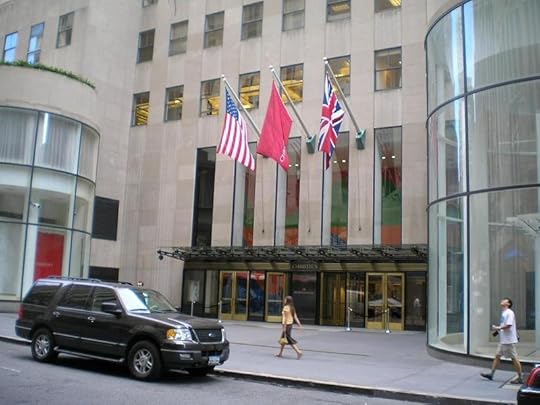 Christie's in Rockefeller Center
Christie's in Rockefeller CenterDavid Shankbone
Of all Christie’s legendary sales, none is more impressive than the one on November 12, 2014, of 80 works of contemporary art, which brought in a record-breaking $852.9 million. Christie’s experts had promoted the sale for months as a once-in-a-lifetime event, and buyers had flocked not only from the U.S. but also the Middle East and Asia. Prominent among the works sold were two by Andy Warhol: “Four Marlons” showing a quadruple Marlon Brando in a leather jacket staring defiantly from under a peaked cap on his motorcycle, which went for $69.6 million; and “Triple Elvis (Ferus Type)” showing three overlapping Elvis Presleys in cowboy garb, legs apart, brandishing a handgun, which fetched an astonishing $81.9 million. Even so, neither topped the $104.5 million paid at Sotheby’s a year before for Warhol’s “Silver Car Crash (Double Disaster)” – a sale that I marveled at in my post #108: “Andy Warhol: Genius or Fraud?” But the two Warhols eclipsed the other items offered, including works by Willem de Kooning and Cy Twombly that also broke auction records for those artists.
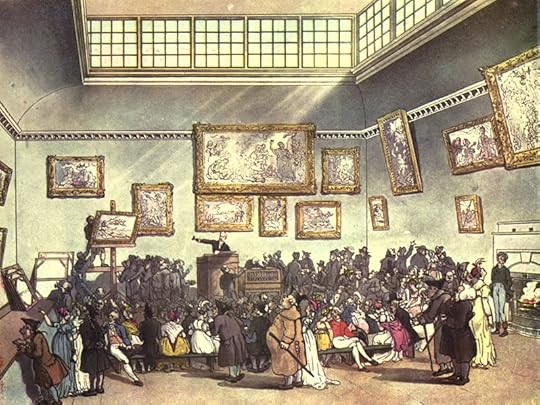 A Christie's auction, circa 1808
A Christie's auction, circa 1808And who paid these remarkable prices? For the Warhols, two unidentified telephone bidders, for such is the discretion accompanying these headline-making sales. Someone somewhere can get his (or her) eyeful of Andy’s quadruple Marlon, and enjoy the thrill of having no less than three Elvises point his handgun right at him. Given what they paid, I wish them well, though therapy might be appropriate. Still, history was made. Said one successful buyer, “The quality of the sale was epic.” But not everyone agreed, as shown by comments appended to a Wall Street Journal online account of the sale:
· How many royalty payments went to the artists or their estates?· I smell a lawsuit coming. Equal pay for equal work.· P.T. Barnum knew his stuff.· “Andy Warhol is the only genius I’ve ever known with an IQ of 60.” Gore Vidal
Whatever happens at Christie’s can have repercussions at Sotheby’s, and vice versa. Christie’s “epic” sale, netting a record $852.9 million, far eclipsed the mere $343.6 million that a sale of contemporary art by Sotheby’s had brought in the night before. It was surely no coincidence that one week later, on November 20, Sotheby’s announced that its longtime CEO, William F. Ruprecht, was stepping down – an announcement hailed by shareholders, it would seem, since shares in Sotheby’s, the oldest listed company on the New York Stock Exchange, jumped more than 7% in after-hours trading. Mr. Ruprecht’s departure was “by mutual consent,” the company insisted, but there was little doubt that it had been prompted by the well-publicized criticism of billionaire hedge fund manager Daniel S. Loeb, a major shareholder, who had long derided Sotheby’s as “an old master painting in desperate need of restoration,” and fiercely criticized its deteriorating competitive position with regard to Christie’s.
Judging from photos, Mr. Ruprecht is a full-faced, chubby gentleman with graying hair who could be your kindly grandfather. Formerly an auctioneer, he is also an expert in textiles and tapestries, so he knows the auction and art scene well.
By way of contrast Daniel S. Loeb, only five years his junior, looks younger and leaner; dark-haired, he radiates an aggressive, almost savage energy. Annoyed by a job inquiry from a U.K. fund manager who cited the applicant’s “place in society,” Loeb replied that his New York-based hedge fund, Third Point, was “a bunch of scrappy guys from diverse backgrounds (Jewish, Muslim, Hindu etc.) who enjoy outwitting pompous asses like yourself in financial markets globally.” Which echoes his reminiscence of the “prep school snotty kids” who treated him like a “jerk” but failed to get A’s when he did. Vibrant he is; subtle he ain’t. And he certainly isn’t your kindly grandfather, more likely an irascible uncle whose visits inspire more dread than joy. His stated aim: to make money for his shareholders.
Loeb, who loves the limelight, takes delight in buying up stakes in underperforming companies and then noisily demanding major changes. Frankly, he thinks Sotheby’s management sucks. Among his many complaints:
· Sotheby’s has lost market share in contemporary art.· Its board owns only 0.87% of the stock, has little “skin in the game.”· Sotheby’s lacks innovation and creativity at senior levels.· It is focused on the short term rather than on long-term investment.· It is slow in developing an online strategy.· It hasn’t wooed millionaire customers in third-world nations like China.· It has wasted money on “legal shenanigans.”· It disregards shareholder interests.· Its CEO remuneration is excessive.
As regards the last point, he mentions Mr. Ruprecht’s $25,000 annual personal automobile allowance (he must be rather mobile), and the company’s paying his country club dues and financial planning fees.
Certainly Daniel Loeb’s criticism merits attention, since he himself is a serious collector of contemporary art, adorning his residences and Park Avenue office with multimillion-dollar masterpieces such as a giant metallic pink-and-blue egg by Jeff Koons, and a sculpture of a crucified frog by Martin Kippenberger. His fondness for metallic eggs and crucified frogs shows that he is no chaser after Rembrandts; his stance is defiantly modern, and that’s what he wants from Sotheby’s. Meanwhile, when not shaking up the business world, he is surfing at a “secret spot” in the Caribbean, or practicing Transcendental Meditation, which involves a 20-minute silent meditation twice a day – a good antidote to the pressures of Wall Street. (Admittedly, I find it hard to imagine Daniel Loeb silent for 20 minutes even once a day.)
William Ruprecht will get severance pay of $4 million and stay on at Sotheby’s until his successor is found, but changes are surely on the way. Will Daniel Loeb’s scathing criticism revive the venerable auction house and let it beat out Christie’s? Time will tell.
Ironically, William Ruprecht became Sotheby’s CEO in a time of crisis. Back in 2000 the art world was shocked, shocked to the bones, to learn that the two colossi of the auction scene had been engaged in price-fixing, which was definitely a no-no and against the law on this side of the pond. It seems that Sir Anthony Tennant, upon becoming chairman of Christie’s in 1992, invited Sotheby chairman Albert Taubman to get together and discuss the affairs of both houses. Meeting at Taubman’s digs in London over a breakfast of scrambled eggs and smoked salmon, each voiced his gripes about the other’s firm and lamented the current state of the auction world. To remedy matters, they then initiated an agreement, the details to be worked out later by their CEOs, not to waive their commissions so as to win major consignments, and even to have a nonnegotiable sliding scale for those commissions, depending on the size of the consignment. Which was definitely price-fixing.
The U.S. Justice Department had its suspicions but no proof, until a new majority owner of Christie’s, French billionaire François Pinault, fired Christie’s CEO Christopher Davidge for alleged extravagant spending. Miffed, Davidge then, like a good citizen, offered his ample notes on the price-fixing deal to Justice in return for amnesty for himself and Christie’s, and an $8 million severance from Christie’s. In short, he spilled the beans. The result:
· Sotheby’s CEO Diana D. Brooks agreed to testify against Taubman, and got 3 years probation, with 6 months detention in her $5 million Manhattan co-op (which must have been rough).· Taubman, Sotheby’s chairman, at age 78 got a year and a day in prison, plus a $7.5 million fine and the cost of his incarceration (an estimated $21,601 a year).· Sotheby’s was fined $45 million.· Christie’s and Sotheby’s both survived the scandal and continue to be the auction houses of choice for the superrich.
So while Taubman’s codefendant Tennant kept his knightly presence aloof and safe in England, Taubman, an untitled American, took the rap, presumably showing that auction house honchos (at least some of them), unlike bankers, are not too big to jail. And this in spite of testimonial letters from such luminaries as ex-President Gerald R. Ford, ex-Secretary of State Henry Kissinger, and Queen Noor of Jordan, not to mention the defense’s claims that the defendant was in poor health, a victim of multiple strokes, and taking 26 pills a day, to which the prosecutor replied, “He still hunts, fishes, plays golf, and travels nationally and internationally.” “No one is above the law,” pronounced the judge. Taubman did indeed go to prison, but when released in 2003, he was picked up by his private jet and was soon attending celebrity social events in New York, following which he was honored by more than seventy Detroit notables at an event in his home state of Michigan celebrating their friendship with him. He was, after all, a well-known philanthropist, and a real estate developer credited with pioneering the modern shopping mall.
 The Taubman Student Services Center at Lawrence Technological University in Southfield, Michigan. No wonder Mr. Taubman is popular in Michigan.
The Taubman Student Services Center at Lawrence Technological University in Southfield, Michigan. No wonder Mr. Taubman is popular in Michigan.When this scandal broke out in 2000, it was none other than William Ruprecht who succeeded Diana Brooks as CEO of the embattled Sotheby’s, hoping to bring peace to its troubled soul and redeem its once sterling reputation. Which he did, more or less, until that nasty Daniel Loeb came along.
But Christie’s has just shocked the art world with a surprise development of its own. On December 2 of this year, a mere three weeks after he presided over Christie’s record-breaking sale of contemporary art, Christie’s announced that CEO Steven P. Murphy is being replaced by Patricia Barbizet, a longtime aide to M. Pinault, the majority owner. Why the change, when under Murphy’s tenure Christie’s has clobbered Sotheby’s in sales of contemporary art? Probably because Christie’s, competing fiercely with Sotheby’s, has been giving up commissions and giving sellers hefty presale guarantees, thus cutting into its profit. M. Pinault apparently got tired of this, hence the change. So another CEO bites the dust. I doubt if I'd care to work for M. Pinault.
But enough of the doings and misdoings of the superrich. What is it like to attend a Sotheby’s or Christie’s auction and bid therein? I have no personal knowledge of such, but a friend of mine does. She informs me that the presale exhibits of the two auction houses are often the best art and antique shows in town, and well worth visiting even if one has no intention of bidding. Over the years she and her husband have seen extraordinary exhibits there of Old Masters, French Impressionists, Americana, and English, Russian, Japanese, Chinese, Korean, and Latin American art, not to mention furniture, carpets, books, and historical memorabilia.
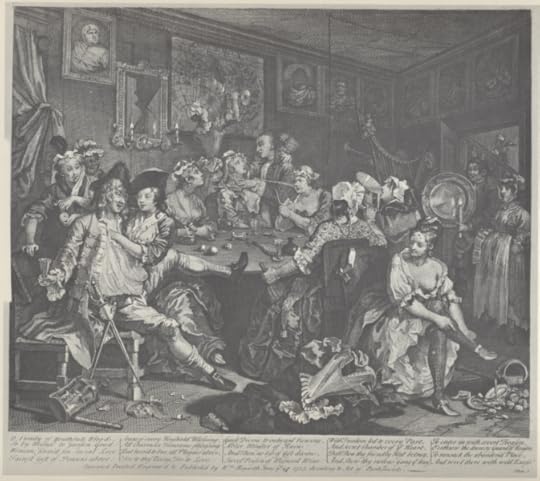 A Rake's Progress, plate 3. A wild party in a brothel, where the prostitutes steal the drunken
A Rake's Progress, plate 3. A wild party in a brothel, where the prostitutes steal the drunken rake's watch.
A real pro, at the exhibits she has never hesitated to speak to one of the experts for information and advice about how much to bid. And bid she does, finding it exciting and fun. She and her husband furnished their East Side apartment with English and American furniture and Oriental rugs from Sotheby’s at prices well below those quoted by retail outlets. A disciplined buyer, she has never bid more than she intended to, and is never depressed if an item escapes her. (I confess that I would be, but then, I’ve never been a buyer.) But the best fun of all, she assures me, comes when you find a bargain because you know more about it than the auction house and the seller. Once, at Drouot, a leading auction house in Paris, they bought a complete set of Hogarth’s famous prints A Rake’s Progress, which had been mislabeled “estampes allemandes” (German prints). As for the difference between the two houses, she thinks Sotheby’s is more popular and Christie’s more elegant, but often finds the objects and art they both offer breathtaking. Her remarks are a reminder that the two houses don’t just cater to the superrich; they have stuff for everyman … and everywoman.
Coming soon: Taxes: Who Pays Them and Who Doesn’t. In the offing: Goldman Sachs: is it really a giant vampire squid?
© 2014 Clifford Browder
Published on December 07, 2014 04:49
November 30, 2014
155. Five Steps to Sure Success for All Bunco Artists, Con Men, and Hoaxers
These shores have seen multitudes of bunco artists and hoaxers, or as we would say today, con men. Just think of all the verbs we have for cheating or swindling: bamboozle, hoodwink, humbug, hornswaggle, flimflam, diddle, fleece, con, gyp, sting, chisel – and probably lots more that escape me now. And New York, being a mecca for hustlers, has had more than its share of flimflam artists. Here, as I see it, are their five steps to sure success:
1. Find something that vast numbers of people need, or think they need.2. Offer a product or service to satisfy that need.3. Through grandiose speeches and gestures, whip the people’s interest up to a fever pitch.4. Get their money.5. Satisfy their need, if you can. But above all, get their money.
Now let’s see these principles in action.
1. Find something that vast numbers of people need, or think they need.
Nineteenth-century Americans, like most people then and now, craved health and well-being. But the medicine of that time had little to offer beyond tender loving care (tlc). There was a vaccine for smallpox and quinine for malaria, but not much else. Which left the field wide open for patent medicine men and their nostrums.
2. Offer a product or service to satisfy that need.
Let’s have a look at New York City in the 1860s. EXTRACT OF BUCHU said handbills distributed throughout the city. EXTRACT OF BUCHU leaped off the signs of sandwichmen marching up and down Broadway, or off big-print posters on the sides of horsecars, or asbestos curtains in theaters, or piles of bricks at construction sites, or booths in public lavatories. Or, more genteelly, off the pages of such popular publications as Godey’s Lady's Book and Harper’s Weekly. Or, less genteelly, off the soaring basalt cliffs of the Jersey Palisades, greeting the gaze of passengers on the steamboats plying the Hudson. And with the completion of the first transcontinental railroad in 1869, EXTRACT OF BUCHU adorned the telegraph poles along the line, and appeared on seemingly inaccessible sides of mountains in the towering Rockies and Sierras, to the surprise and instruction – or outrage – of travelers by rail.
And what did Extract of Buchu do? Said an ad of the time, it
· Cures Gravel· Cures diseases of the bladder· Cures diseases of the kidney· Cures dropsy· Cures general weakness· Cures all diseases arising from exposure
To which was added JOY TO THE AFFLICTED, and a list of symptoms that included dimness of vision, languor, temporary suffusion, loss of sight, etc., which, if untreated, could result in insanity and consumption. But there was hope:
With woful measures, wan Despair,Low, sullen sounds of grief beguiled,HELMBOLD’S EXTRACT OF BUCHU givesHealth and vigor to the frame,And bloom to the pallid cheek.
And all this for only $1 a bottle, or six for $5, deliverable to any address.
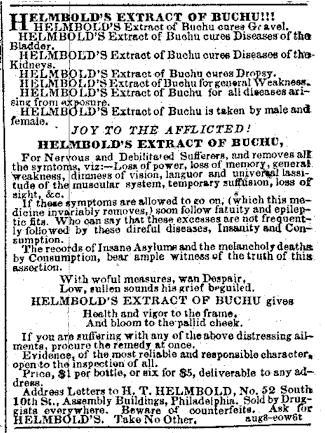
Another ad called Helmbold a “Practical and Analytical Chemist” and showed Hottentots gathering buchu leaves in huge bundles addressed to the doctor in New York. Another praised the Extract as standing “like the Doric column … simple, pure, and majestic, having fact for its basis, induction for its pillar, and truth alone for its capital.”
What, in fact, was this Extract of Buchu, and who was Henry T. Helmbold?
[image error] Agathosma betulina The Extract was made of the leaves of the exotic buchu plant (yes, it really exists: Agathosma betulina), plus cubebs (also known as Java pepper), licorice, caramel, molasses, and a dash of peppermint. Buchu was a plant growing in South Africa among the Hottentots, who had long used it as a medicine and cosmetic, rubbing the powdered leaves on their skin to impart a fragrance akin to peppermint. It had reached this country by 1840 and was listed in the Pharmacopeia as a stimulant producing diuresis (in other words, it helped you urinate).
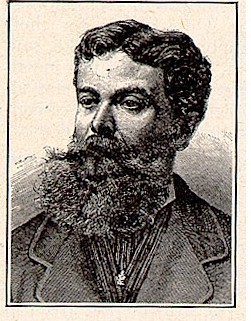 Helmbold Henry T. Helmbold had begun his business career in his native Philadelphia as a retail druggist without even a degree in pharmacy and with capital, so he later said, of fifty cents. His life changed one day in 1850 when, at age 24, he discovered buchu and, in a fit of inspiration, began producing his extract in a rented basement. Advertising in local newspapers, he was immediately and even wildly successful and in 1863 transferred his genial presence from the City of Brotherly Love to the turbulent, growing, and infinitely exciting city of New York.
Helmbold Henry T. Helmbold had begun his business career in his native Philadelphia as a retail druggist without even a degree in pharmacy and with capital, so he later said, of fifty cents. His life changed one day in 1850 when, at age 24, he discovered buchu and, in a fit of inspiration, began producing his extract in a rented basement. Advertising in local newspapers, he was immediately and even wildly successful and in 1863 transferred his genial presence from the City of Brotherly Love to the turbulent, growing, and infinitely exciting city of New York.3. Through grandiose speeches and gestures, whip the people’s interest up to a fever pitch.
Let us join the crowds on busy Broadway on a morning in the late 1860s. Among the flux of carriages, drays, stages, express trucks piled high with luggage, lager beer wagons, and milk carts with clattering cans, there suddenly appears a handsome barouche ornamented in gold and pulled by three high-stepping horses in tandem, the head of each adorned with violets. Suddenly, at a command from the black coachman, the horses rear up on their hind legs together, a stunning sight to see. Then, as the shiny black carriage approaches a palatial establishment at 594 Broadway, where crowds are waiting to witness its arrival, the barouche comes to a halt, and from its depths, attended by footmen in livery, steps a small, fashionably dressed man with a lustrous black beard and topped by a dark silk hat. Nervous and energetic, he walks briskly toward the huge glass doors of no. 594, which open as if by magic to admit him to its sumptuous depths. Henry T. Helmbold, king of the patent medicine men, has arrived at his Temple of Pharmacy.
Yes, an obviously grandiose gesture, well calculated to seize the public’s attention. But inside the spacious, high-ceilinged store the royal progress continues. Passing uniformed clerks at their counters and attendants and bookkeepers and managers who greet him deferentially, the sovereign of the Temple of Pharmacy proceeds to the back of the store and a small private office with a sign above the glass door announcing SANCTUM SANCTORUM, inside which his desk awaits him, and a bust of himself in an exotic wood. The door closes, silence; inside, the doctor is communing with his Muse, or whatever source inspires him in his tireless promotion of Extract of Buchu.
Helmbold's pharmacy at 594 Broadway.
Always in pursuit of the grandiose, Dr. Helmbold (a self-imposed title) had spent a fortune building his Temple of Pharmacy, installing sarcophagus soda fountains, floor-to-ceiling mirrors, monogrammed gas globes, marble floors with his initials inlaid in brass, perfume-dispensing fountains, and canaries singing in their cages. Atop the roof was a full-rigged ship, supposedly Helmbold’s own yacht dismantled and reassembled there, but in fact a dummy with masts, spars, and rigging.
So “buchuful” an edifice on Broadway drew multitudes of citizens, among them such luminaries as Boss Tweed, robber barons Jay Gould and Jim Fisk, Commodore Vanderbilt (the richest man in America, known endearingly as “Old Sixty Millions”), John Jacob Astor III (there was a slew of moneyed Astors), and New York Herald publisher James Gordon Bennett. Sightseers from the hinterland made a point of visiting the emporium, hoping as much to get a glimpse of the doctor himself as to revel in the luxury of his establishment. In short, he dazzled the city and the nation.
4. Get their money.
He did, and in no small amount, for at the peak of his career he is said to have been earning a million dollars a year, and by 1869 he was spending $500,000 a year on advertising. He lived in a residence at 156 West 14thStreet (though some sources say Fifth Avenue), where his entertainments of the press and drug trade were catered by Delmonico’s. His stable at 142 West 17thStreet housed from 18 to 20 carriage and saddle horses, all Kentucky-bred.
In 1868 Helmbold bought a summer residence in Long Branch, the nation’s summer capital frequented in season by President Ulysses S. Grant himself and members of his cabinet, and other stellar figures from the worlds of politics and finance. Thereafter, the doctor’s elegant four-in-hand was at times graced by the cigar-smoking President himself. But Helmbold also built a whole row of business houses on Ocean Avenue and Broadway, following which that location became known as Helmbold’s Block. All in all, then, his was the life of a multimillionaire typical of the Gilded Age, but more flamboyant.
5. Satisfy their need, if you can. But above all, get their money.
Yes, he got their money, but did he satisfy their need? Of course not, no more than any patent medicine man ever did. In a signed affidavit he swore that his extract contained no narcotic, no mercury, or any other injurious drug, being purely vegetable in content. So no one got genteelly high on his product, as they did on some other nostrums with a significant alcoholic content. But even if buchu and cubebs had the medicinal value that tradition assigned them, there is no reason to think that Helmbold’s Extract of Buchu was in any way beneficial. It did no harm, but neither did it do any good, except to Helmbold’s bank account.
So much for Helmbold the con man, but there is more to his story. One senses in his flamboyance, his grandiose gestures and fanatical promotion of his extract, a certain compulsiveness, even an obsession. He became an alcoholic, though apparently a binge drinker who between bouts was rational and sane. In 1871 he took his wife and children on a tour of Europe and the Orient, and in Paris on July 4, 1872, he invited all Americans in the city to be his guest at a reception said to have cost $19,000 for wine, flowers, and other incidentals. Among the guests on that occasion was the Shah of Persia, who came to pay his respects. But his lavish spending was accompanied by increasingly eccentric behavior and, finally, irrational outbursts of rage over the slightest trifles, and even an attempt to kill his wife. As a result, the seer of buchu was confined to an insane asylum.
Meanwhile back in America there was an attempt by his brother Albert L. Helmbold to get possession of his business. What exactly happened is unclear, but on September 13, 1872, the free-spending Henry T. Helmbold was declared bankrupt, and the Temple of Pharmacy was padlocked. In the words of an associate, Helmbold was “often crazy drunk,” and as a result he was declared insane and confined to an asylum, first in Paris and then, when he managed to return to this country, over here. His brother Albert brought suit, claiming title to and use of the Extract, and furthermore alleging that Henry was a lunatic. But in 1877 the Supreme Court of New York State denied Albert’s claim and found no hard evidence of Henry’s insanity. In that same year of 1877 Henry, now at liberty, published a book entitled Am I a Lunatic? Or, Dr. Henry T. Helmbold’s Exposure of His Personal Experience in the Lunatic Asylums of Europe and America. But the New York Times of May 2, 1878, announced in bold letters
HELMBOLD AGAIN RAVING; HE ISATTACKED BY DELIRIUM TREMENSIN A STRAIT-JACKET AND STRAPPEDTO A BED IN BELLEVUE HOSPITAL.
Obviously, Helmbold’s path back to sobriety was a long and tortuous one with many relapses – seven, according to an associate – during which he was given to grandiose delusions, including the intention to get himself nominated as a candidate for President to run again Ulysses S. Grant. But in 1881, when he was confined to a hospital in Norristown, Pennsylvania, his wife assured the court that he was perfectly sane and anxious to return to his family, having long abstained from alcohol and promised never to drink again. In time, he was released.
Even his end is a bit of a mystery. According to associates, he died on September 12, 1892, at his home in Long Branch. But a New York Times article of October 25 announced that he had died suddenly the day before in New Jersey’s State Asylum for the Insane, and that his body was at an undertaker’s establishment awaiting the orders of his family, who so far had failed to respond to the telegraphic notice. All in all, an enigmatic and grandiose existence, hard to match except on the stage or in a madhouse. But a forgotten one. I have found no mention of him in The Encyclopedia of New York or Gotham: A History of New York City to 1898, both of them voluminous sources.
Should one include among the bunco artists and con men of nineteenth-century America the railroad men who, even as Helmbold was touting his Extract of Buchu, were busy promoting their enterprises? Wall Street was usually where these schemes were hatched, but they inspired hopes and visions everywhere. Let’s see how the promise of a railroad affected one small community some fifty miles north of New York City. Here the emphasis will be, not on the often nameless promoters, but on the community itself, as recorded in old issues of the Putnam County Courier.
1. Find something that vast numbers of people need, or think they need.
In the mid-nineteenth century the village of Carmel, the county seat of Putnam County since the county's creation in 1812, found itself in the sorry state of being connected to the outside world only by stage lines, whereas the upstart village of Brewster, a mere five miles away, had mushroomed out of nowhere with the coming of the New York & Harlem Railroad in 1849, when a depot was built on the site. Shrewd local speculators had bought up farmland, and on those lands houses, stores, and factories had sprung up, all made possible by the village’s connection by rail to that metropolis some fifty miles to the south. In that exuberant age when the completion of the first transcontinental railroad in 1869 had spawned a host of railroad projects in the distant and desolate West, how could the citizens of Carmel not dream also of a railroad to connect them with the rest of the nation, and most specifically with the city of New York? Here then was a potent need waiting to be fulfilled.
2. Offer a product or service to satisfy that need.
In 1869 word came that something called the New York & Boston Railroad was projecting a line from New York City north to Carmel and then to Brewster, where it would connect with the New York & Harlem line. This, citizens were told, was a grandiose plan conceived by some “big-brained men” who “meant business.” Monkey business? No, real business, as was explained in detail to a meeting of citizens in a hotel at nearby Lake Mahopac, another community to be served by the railroad. There, on August 14, four directors of the railroad described the projected route and invited subscriptions of stock. The chairman of the meeting was the Reverend William S. Clapp, a respected Baptist minister and the most prominent clergyman in the county, while financier Daniel Drew, the local boy who had made good on Wall Street, was in attendance and informed the railroad that it could run through any of his farms in the area free of charge. No one present doubted the success of the enterprise.
The question now was whether or not other landowners would follow Daniel Drew’s example and give the railroad right of way across their land, for if they failed to do so, the hoped-for railroad might bypass Carmel altogether – the fear that always haunted communities yearning for a railroad. But soon the Putnam County Courier could report that seven-eighths of the local landowners along the route had given their land to the company, prompting the paper to announce, “Such liberality is without precedent in the history of railroads.”
3. Through grandiose speeches and gestures, whip the people’s interest up to a fever pitch.
The railroad men had no need of the grandiose gestures of Helmbold, for the mere promise of a rail connection to the outside world dazzled the good folk of Carmel, who whipped themselves up to a fever pitch. Prominent in the campaign was the Courier itself.
4. Get their money.
The railroad’s demands were substantial. It required no less than $100,000, a sum to be raised by subscriptions of stock. Nearly half that amount had been raised by mid-November 1869, when meetings of citizens were being held nightly, and committees named to urge immediate action by those interested. If the railroad was to pass through Carmel, the full sum had to be obtained, and obtained quickly; another $37,000 was needed, and yet some big local property owners were holding back. “Now or never!” declared the Courier. Then, on November 24, another meeting of citizens was held in a Carmel hotel, and a resolution was passed to pay the railroad the amount subscribed in 10% installments, each when another tenth of the work had been completed, an arrangement that suggests that the citizens’ enthusiasm was being seasoned with a touch of practicality, or even canniness. Fortunately, the railroad agreed.
5. Satisfy their need, if you can. But above all, get their money.
Early in 1870 engineers appeared in the vicinity of Carmel to make a final survey of the route. Then, on February 14, ground was broken for the line in spite of a pelting rain. Flags flew along the main thoroughfare and from the dome of the Ladies Seminary, and church bells rang. Rain or no rain, a procession marching to the site included the Carmel Brass Band, clergy, orators, journalists, company officers, engineers and their instruments, stockholders and citizens, and railroad laborers with picks and shovels. After a solemn prayer, the Reverend Clapp was chosen by unanimous vote to break ground and remove the first shovelful of earth. The Reverend, a hefty gentleman with a bushy walrus mustache, was more than up to the job, following which the meeting was adjourned to his elegant carriage house, where food was provided to all, as well as speeches by the Reverend and others. Finally, the soggy participants gave three cheers for the New York & Boston Railroad. Clearly, Carmel’s dream was coming true.
The Courier of September 10, 1870, reported that 80% of the railroad was now completed in Putnam County, but on November 25, 1871, a whole year later, it could only report that work was continuing, with the new line due to commence operation the following summer. Meanwhile the railroad was undergoing a bewildering series of name changes, becoming the New York, Boston & Northern Railway in November 1872, and then the New York, Boston & Montreal Railway in January 1873. Happily, the Courier of May 4, 1872, quoted an ad from the New York Commercial Advertiser of April 26 reporting that work on the line to Montreal was under way, despite opposite from Commodore Vanderbilt, aka Old Eighty Millions, who wanted no competition for his New York Central line. “These are indeed gigantic schemes,” said the Commercial Advertiser, “but they are no grander than the times demand…. Only a little longer can an old fogy generation seal up this metropolis…. It is manifest destiny – you cannot dam up the Bosphorus – you cannot dam up the Empire City.” So little Carmel would be linked not only to New York City but also to distant Montreal; manifest destiny indeed.
 What the citizens of Carmel longed for and finally got.
What the citizens of Carmel longed for and finally got.Work on the railroad suffered a long interruption when winter came, but construction resumed in May 1873. On the morning of September 4 the shrill whistle of a locomotive was heard for the first time in Carmel, as a train arrived from Brewster, signaling the completion not of the whole line, but of the all-important segment linking Brewster and Carmel. A direct connection between Carmel and all other important points on the line was expected by the summer of 1874, at which point manifest destiny would finally be fulfilled.

Alas, destiny received a rude jolt in September 1873, when failures on Wall Street precipitated a financial convulsion that would come to be known as the Panic of 1873. Stocks plunged, trust officers vanished into fairyland, bankruptcies multiplied, factories shut down, railroads failed, thousands were thrown out of work, and the whole nation was plunged into a six-year depression. By late November the Courier reported that all work on the almost completed railroad had ceased, with hopes that the suspension was temporary. But when, in August 1874, the railroad’s treasurer came to Carmel and announced that work would resume shortly, the Courier confessed to a faint memory of having heard this before. More rumors followed, and more reorganizations. In 1877 the New York, Boston & Montreal Railway became the New York, Westchester & Putnam Railway, the grandiose project of reaching Montreal having mysteriously disappeared. Whatever its name, the long-promised and much-delayed railroad finally opened on December 23, 1880, with the first train carrying six passengers and thirty-nine cans of milk – a modest enough achievement for a line once projected to reach all the way to Canada. Still, Carmel at last had its rail connection, a mere thirty-one years after Brewster got the same. Destiny had, after a fashion, been achieved.
For a while. When, in the 1970s, I began researching a biography of Daniel Drew and needed to consult county records and the Putnam County Courier in Carmel, no railroad could take me there. Instead, I had to take the Harlem line to Brewster and then continue to Carmel by taxi. How could this be? The answer became apparent when, at 5 p.m., having finished my day’s research in Carmel, I was ready to taxi back to Brewster, and witnessed in the center of Carmel a traffic jam every bit as bad as traffic jams in New York. The automobile had long since supplanted the railroad.
Should the “big-brained men” who promised a rail connection to Carmel and hit its citizens for thousands of dollars be classified as bunco artists and con men? No, they really meant to build their railroad, and that railroad, when it finally began operation, was a tangible thing of iron and steel. This, I suspect, was the case with most railroad promoters of those giddy times prior to the Panic of 1873, even if no track was ever laid. If they were con men, they were conning not just the public but themselves, and that’s the worst kind of con there is.
And who are the bunco artists of today? Your guess is as good as mine. Off the top of my head I propose the following:
1. Hedge fund managers2. Big Pharma3. The military industrial complex4. Psychiatrists5. Politicians
#2 and #4 often work together, inventing all kinds of new syndromes that #2 can allegedly treat. As for #3, all these wars that never seem to end. And for #5, conning the public – and sometimes oneself – is an inherent part of the game. Am I being cynical? No, just realistic. And what are our needs that these good folk promise to fulfill? Wealth, health, security, a better life. We will always crave these things, and someone will always be on hand to promise them. And rarely, very rarely, someone will actually deliver.
A New York vignette: Last Sunday, as I was lunching in a little Indian restaurant on Bleecker Street, out the window I could see these establishments across the street:
· Caliente Cab Co. / Tequila Bar· Kumo Sushi· Fish / Raw Bar / Fish· John’s Pizzeria / Since 1929· Ramen Thukpa
The cab company is, of course, a Mexican bar. The first four are juxtaposed along Bleecker. Ramen Thukpa, visible in the distance across Seventh Avenue, was for me a mystery at the time, but now, thanks to quickie online research, I know it to be a Japanese and Tibetan restaurant. Once again, diversity. And that is truly New York.
One more touch of New York: As I looked out the window while lunching, a panhandler stationed himself on the sidewalk outside. He was a bearded older man in a jacket and jeans, wearing a tassel-topped knit cap that said NEW YORK. He accosted passersby while flaunting a sign:
VET NEEDS FOODAND BUS FARE HOMEI DON’T TALKDC
And he didn’t talk, though anyone who gave him some spare change was greeted with a smile and a thumbs-up. At one point he noticed me watching from the restaurant and gave me also a smile and a thumbs-up. I was going to give him something when I left, but by then he had disappeared. There was a time when, like most people, I would have walked past without acknowledging him, but in my old age I’ve gotten soft; I’m now more likely to give than not to give, and to add a friendly “hello” as well. But this is New York, so I’ll probably never see him again. He looked authentic; I hope he’ll get some food and get home.
WBAI and WNYC: As followers of this blog know, I listen to both these listener-supported radio stations. WBAI, having just failed to meet its goal in a fund drive, has immediately launched another fund drive – which is almost without precedent. Soon it will have fund drives going year round, without interruption. They are, of course, desperate. Their loyal base of contributors is shrinking, and they’re constantly changing programs to hook more listeners, but so far it doesn’t seem to be working. Some of the changes are good, but when you tune in, you have no idea what you’ll hear. Last night I encountered a spiel for “neuro design engineering” and “transitional hypnosis.” For a contribution of $150 you could be instructed in these mysteries, which will change your life. In fact, you will be certified in them and can start your own consulting business charging $150 an hour. Some of those participating have already snagged their first clients at that princely hourly sum – hurrah! Which reminds me of those online ministerial schools that will give you a quickie ministerial degree allowing you to claim all the benefits of clergy – and there are many, including tax breaks – allowed by law. When I’d heard enough of this exuberant spiel, I switched to WNYC, which is offering a series of very moving reminiscences by family members and significant others of all the pedestrians who died recently in traffic accidents in the city. My personal conclusion: score one, and a big one, for WNYC.
Coming soon: Sotheby’s and Christie’s and Bunny and Andy, and Who Goes to Jail and Who Doesn't.
© 2014 Clifford Browder
Published on November 30, 2014 04:37
November 23, 2014
154. West 4th Street Shops: Bongs, Gongs, and Thongs, plus a Killing
West 4thStreet between Sixth and Seventh Avenue, which I have often walked when toting wines home from the Lower East Side, has a rich, weird assortment of shops. Starting from Sixth Avenue and heading west toward Seventh on the uptown side of the street, here is what I’ve found. Omitted street numbers indicate residential buildings, which are interspersed with the shops. First, Tic Tac Toe at 161 West 4th, with a sign outside showing one young woman paddling another with a hair brush. Needless to say, this suggests a frothy mix of the naughty and sensual, and the suggestion is not so far off, since the store has been described online as a clothing store selling “adult lingerie” or, more bluntly, as a “sex shop.” Well, okay. Though I’ve never ventured inside (I’m not, in any way, into “adult lingerie”), I’m sure that frilly and abbreviated apparel await one within. But there’s more than that, since a sign on the sidewalk with the same spanking scene lists these offerings:· BRIDAL/BACHELOR PARTY STUFF· ROMANTIC GAMES AND MASSAGE OILS· ADULT TOYS· FETISH ACCESSORIES· LINGERIE AND DANCE WEAR· MEN’S UNDER WEAROnline reviews vary from raves to pans, the raves praising it for blow-up dolls, gag gifts, vibrating dolphins, and even “pasties” (whatever they are), while the pans decry the staff as slouchy, gossipy, immature, and rich in profanity; take your pick. But the sign and window display provide a nice spicy start for our stroll toward Seventh Avenue. (Further research reveals that “pasties” are adhesive patches to cover the nipples.) Burlesque at 163 West 4th is seemingly a competitor of Tic Tac Toe, with more scantily clad sexy manikins in the window, plus the added enticement, “All costumes on sale.” Yet when I check them out online, the reviews mention jewelry, gifts, hats, and bags. A mystery. The Four-Faced Liar at 165 West 4th is another mystery, since there is an array of liquor bottles in the window, but it is most definitely closed. Going online, however, I find it described as a welcoming and unpretentious Irish pub, so maybe my afternoon walk was ill-timed; it may open later. But I’m looking for shops, not bars. Next door is the Pink Pussy Cat, at 167 West 4th, whose windows, featuring minimally clad manikins, proclaim it yet another competitor to Tic Tac Toe. Here, without entering, we can have an inside look at a sex shop, thanks to the published account of a young woman who, recently arrived from Yugoslavia in 1989, was living in Queens on a rented mattress at $50 a week. Needing a job, she got one at Pink Pussy Cat without even knowing what the boutique’s name implied or what “sexual paraphernalia” meant. Paid $8 an hour plus commissions, she soon found herself selling sex toys like strawberry-flavored underwear, and a few others like mouthless masks and nipple clamps that were a bit scary. The customers included happy couples, the men querying about the items while their wives or girlfriends pretended to be bashful, or callow youths from New Jersey who blushed crimson at the sight of black crotchless lace teddies. But the hours were long – from 6 p.m. to 2 a.m. -- and when she objected to working seven days straight through the holiday season, she was fired.
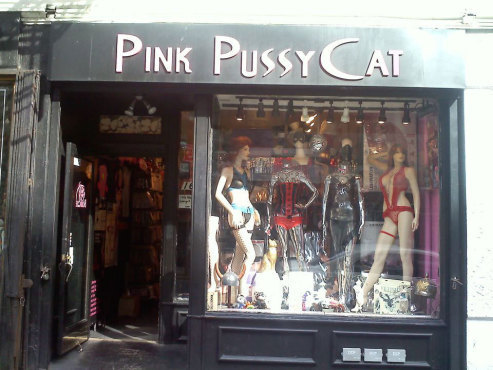 Piquantly juxtaposed with the Pink Pussy Cat is Music Inn at 169 West 4th, a store with bins of old music books and records for sale out in front, plus chairs in desperate need of a paint job but inviting visitors to sit, and windows displaying guitars, chimes, and even a laundry board, plus a sign reading EXPERT INSTRUMENT REPAIR. In addition, its website offers a wide range of instruments including electric zarods – whatever that may be – as well as Music Inn T-shirts and comics. Shisha International at 171 West 4th is what’s known as a smoke shop, with the most amazing window display on the block, featuring a rich mix of accouterments comprising what I take to be glass water pipes (bongs) and hookahs, vaporizers, a smoke odor exterminator, and cigarette lighters, with a few grinning skulls interspersed that may or may not be sending a message. If I linger here, it’s because the display fascinates and baffles me; a nonsmoker, I have no idea what all these objects are, least of all the water pipes (?), skinny totem poles of glass bulbs often two feet high, and one that towers up to an astonishing five feet. For an added touch of atmosphere, a wooden cigar store Indian stands by the entrance, and another taller one greets you just inside the door. Online reviews hail Shisha as a mecca for smokers and describe the staff as knowledgeable and friendly. And one review tells how a friend of his bought a high-end glass hand pipe for $130, took it home, and then discovered, as he and his buddies passed it around, that it was in fact an anatomically correct penis pipe! But they smoked it anyway and had a fine evening.
Piquantly juxtaposed with the Pink Pussy Cat is Music Inn at 169 West 4th, a store with bins of old music books and records for sale out in front, plus chairs in desperate need of a paint job but inviting visitors to sit, and windows displaying guitars, chimes, and even a laundry board, plus a sign reading EXPERT INSTRUMENT REPAIR. In addition, its website offers a wide range of instruments including electric zarods – whatever that may be – as well as Music Inn T-shirts and comics. Shisha International at 171 West 4th is what’s known as a smoke shop, with the most amazing window display on the block, featuring a rich mix of accouterments comprising what I take to be glass water pipes (bongs) and hookahs, vaporizers, a smoke odor exterminator, and cigarette lighters, with a few grinning skulls interspersed that may or may not be sending a message. If I linger here, it’s because the display fascinates and baffles me; a nonsmoker, I have no idea what all these objects are, least of all the water pipes (?), skinny totem poles of glass bulbs often two feet high, and one that towers up to an astonishing five feet. For an added touch of atmosphere, a wooden cigar store Indian stands by the entrance, and another taller one greets you just inside the door. Online reviews hail Shisha as a mecca for smokers and describe the staff as knowledgeable and friendly. And one review tells how a friend of his bought a high-end glass hand pipe for $130, took it home, and then discovered, as he and his buddies passed it around, that it was in fact an anatomically correct penis pipe! But they smoked it anyway and had a fine evening.
 Hector Garcia Also located at 171 West 4th is Juice Generation, which advertises smoothies, juices, cold pressed açai bowls (again, I plead ignorance), and “shots and boosts.” Among the items listed on a menu brochure available outside are Supa Dupa Greens, Tropical Lust (“watermelon, pineapple, apple & ginger”), Red Dragon Fruit, Mucho Mango, Multi-V Squeeze, Protein KnockOut, Ginger Fix, and Vital Shot. As for the “açai bowls” just mentioned, a quick bit of online research reveals that the açai palm grows in the swamps and floodplains of Trinidad and northern South America, and that the fruit, a small, round, black-purple berry, is eaten or made into a beverage. In fact, the berries are now hailed by some as a superfood with anti-aging and weight-loss properties, which may explain why they have made there way into West 4thStreet, though Juice Generation makes no such claims. What is does offer includes Almond Butter Bliss, an açai bowl whose ingredients include açai, banana, almond milk, almond butter, coconut, and hemp granola, and Amazing Green, an açai bowl with spinach and kale. The store’s message of the joys of juicing is a welcome contrast to the smoke shops and sex shops all around it, and further proof that this one short stretch of West 4thStreet endeavors to satisfy all our cravings, licit and illicit alike.
Hector Garcia Also located at 171 West 4th is Juice Generation, which advertises smoothies, juices, cold pressed açai bowls (again, I plead ignorance), and “shots and boosts.” Among the items listed on a menu brochure available outside are Supa Dupa Greens, Tropical Lust (“watermelon, pineapple, apple & ginger”), Red Dragon Fruit, Mucho Mango, Multi-V Squeeze, Protein KnockOut, Ginger Fix, and Vital Shot. As for the “açai bowls” just mentioned, a quick bit of online research reveals that the açai palm grows in the swamps and floodplains of Trinidad and northern South America, and that the fruit, a small, round, black-purple berry, is eaten or made into a beverage. In fact, the berries are now hailed by some as a superfood with anti-aging and weight-loss properties, which may explain why they have made there way into West 4thStreet, though Juice Generation makes no such claims. What is does offer includes Almond Butter Bliss, an açai bowl whose ingredients include açai, banana, almond milk, almond butter, coconut, and hemp granola, and Amazing Green, an açai bowl with spinach and kale. The store’s message of the joys of juicing is a welcome contrast to the smoke shops and sex shops all around it, and further proof that this one short stretch of West 4thStreet endeavors to satisfy all our cravings, licit and illicit alike.
 A grove of Açai palms in Brazil.
A grove of Açai palms in Brazil. You can even do it to yourself, if
You can even do it to yourself, ifyou're careful.
Bjorn Bulthius Village Four Nails & Spa at 175 West 4th features manicures ranging from $8 to $45 (French Color Gel Manicure, $45), artificial nails that top out at $100 for “UV Gel Permanent French,” pedicures ranging up to $60 for a “Honey Silky Milk Spa Pedicure,” waxing of various body parts (“Upper Legs with Bikini, $45”), and special treatments that include eyelash tinting ($25), ear candling ($30) (??), 10-minute reflexology for $13, and eyelash extensions ($40 and up). (Ear candling, I have now learned, is an alternative medicine procedure meant to improve health and well-being by lighting one end of a hollow candle and inserting the other end in the ear canal. Which is all right, I suppose, as long as the practitioner doesn’t reverse the candle by mistake.) But that’s not all that Village Four offers. How about a 60-minute Hydrolifting Facial for $90, or a 70-minute Deep Prone Clearing Treatment for $110? All of which, to this ignorant male, sounds pretty overwhelming. And I learn online that Village Four aestheticians (yes, that’s what they call them) often begin an appointment with a complimentary glass of champagne (Moët & Chandon, let’s hope). And after all this, reinforced by a smoothie at Juice Generation, one is certainly ready for Tic Tac Toe or the Pink Pussy Cat. At 177 West 4th we come to another smoke shop, Smoking Culture (“For all your smoking needs”), with more glass pipes and houkahs and other handblown glass contraptions in the window. Recently it became known for much more than the products it sells. Tipped off by an irate girlfriend and the shopowner, on July 28 of this year two federal marshals and a New York City police detective entered the store to arrest Charles Mozdir, an employee wanted on child molestation charges in California. Confronted, Mozdir whipped out a handgun and opened fire, wounding all three law officers amid a rain of shattered glass, before their return fire killed him. Outside, West 4thStreet emptied quickly as pedestrians fled the scene, and the street was roped off for hours as the police investigation continued. Protected by their bullet-proof vests, the officers survived, as did Smoking Culture itself. But in Mozdir’s pockets the police found twenty more rounds. Next door is Village Cuts, a barbershop at 179 West 4th Street (haircut $21), promising whatever look the customer desires. “Walk-ins welcome,” a sign indicates. At 181 West 4th there are two establishments, one upstairs and one down. Upstairs is Ramen-ya, which I took for a Japanese massage parlor or something similar. But no, going online I learn that it is a tiny hole-in-the-wall Japanese restaurant and noodle house with excellent reviews. I shan’t linger, since I’m not surveying restaurants or bars. Downstairs at 181 is Okuyama Bodywork, offering massages for deep-tissue, neck, and lower back pain, as well as stress relief and sports injuries, and reflexology. “Therapies range from basic energy to potent yet careful and exquisite stretches that incorporate a variety of respected techniques,” it explains online. Privacy and strict etiquette are promised; this isn’t one of those places. Reviews, including one by a reviewer who says “I don’t normally right reviews,” are excellent, emphasizing the personal attention you receive, the sustained effort by the masseuse to get to the root of your problem. So here’s another leap toward health. Passing two residential entrances, at 187 West 4th we come to the Patisserie Claude, a small pastry shop with Parisian-style pastries and coffee. There are only four little tables in front, plus a counter displaying their wares, but when I pass by there’s usually at least one or two seated patrons nibbling goodies. It looks tempting, and far more relaxing and casual than the crowded Magnolia Bakery (see post #153), but it’s usually close to noon when I pass it, and I can’t afford to spoil my appetite for lunch. Online reviews are unqualified raves, extolling the “chocolate Moose cake,” croissants, éclairs, tarts, and quiche. Claude is evidently the baker in charge, but what his “Moose cake” tastes like, I can’t imagine. But then, I’m a vegan, so what does it matter?
 Gâteau à base de mousse au chocolat, which translates as
Gâteau à base de mousse au chocolat, which translates as"chocolate mousse cake." And not an antler in sight.
Lionel Allorge Passing a cleaner and tailor at 189 West 4th, we come to Considerosity at 191, featuring the “Art of Thoughtful Gifting,” with what seem to be large fans (not the electric kind) in the window. By now we’re nearing the end of the walk, so I haven’t lingered here. But online I learn that the store is crammed with handmade jewelry, artisanal home accessories, candles, cologne, bottles, handbags, mugs, bowls, you name it, and at reasonable prices. Gifts for everyone, it appears. A nice note to almost end on. The end of the walk comes at 193 West 4th with Petite Optique, which claims to be “the most exclusive European eyewear boutique in New York.” They boast a collection of frames that is truly unique. Click on “Collections” on their website and you will be offered a host of designer names from all over the world – BOZ, Cutler & Gross, Factory 900, ic Berlin, Lindberg, Mykita, RAPP, Theo, and many more. Never heard of them? That’s the point: these are exclusive designers from all over the world, not available elsewhere in the city. And if you click on any one of the names, you will be shown a photo of an attractive model wearing the frames in question. You may not look like the model, but the frames are certainly distinctive. A nice upgrade note to end our walk on, as we come to the Sheridan Square Viewing Garden and Seventh Avenue. Now that we’ve seen a lot of New York shops, what can we say distinguishes them, regardless of what they offer? Something rare, unique, not to be found just anywhere. It may be houkahs, zarods, açai bowls, a Hydrolifting Facial, a “chocolate Moose cake,” adult lingerie, or glasses frames by BOZ, but the chances of your finding the item elsewhere in the city are slim. (One exception: adult lingerie seems to abound, though only in a certain kind of shop.) And in the past? Were there shops with unique offerings back then, too? Let’s go back to the 1860s and take a quick glance. Tiffany’s was flourishing then too, but only beginning to be a big operation with international renown. Located at 550-552 Broadway, with a carved wooden Atlas above the door shouldering a huge clock, the store offered a cluttered window display of Victorian objets d’art: bronze figurines, silver teapots, vases of every size and shape, necklaces draped over bowls and jewel boxes, Chinese carvings, goblets, jeweled clocks, paperweights, and fans – just the kind of stuff that the residents of brownstones used to clutter up the mantels and whatnots of their parlors. The founder of the store, Charles Lewis Tiffany, had never intended it to be a mecca for the wealthy; rather, he courted a mass market for his wares. Always on the lookout for unusual items, he snapped up diamonds dumped on the market by fleeing aristocrats in the wake of the 1848 revolution in Paris, and later, even Marie-Antoinette’s girdle of diamonds, which he broke up into pieces to sell, so as to avoid embarrassing questions about just how the girdle had been acquired. In 1856, having bought a perfect pink pearl from a New Jersey farmer who had found it in his dinner mussels, Tiffany sold it to the Empress Eugénie of France. As news of the sale spread, it prompted a rush throughout the country to rake the brooks in hopes of another such find. But in his shop, mass market or not, he forbade the customary haggling; each item was tagged with its price, and that was final.
 Tiffany's at Union Square, circa 1887.
Tiffany's at Union Square, circa 1887.Tiffany’s today can hardly be called a quaint little shop, yet its store at 727 Fifth Avenue still features the wooden Atlas above its Fifth Avenue entrance. I have never set foot in it, but long ago my partner Bob went there to buy a gift for his mother, and for $25 – a tidy sum, in those days – acquired a sterling silver letter opener that adorns his desk today. Its design is the soul of simplicity, and only with a magnifying glass can you make out the tiny inscription:TIFFANY & CO. STERLINGDiscretion, not flamboyance, is the rule today.
 Matthew Brady, circa 1875. One other shop of the 1860s merits attention: Matthew Brady’s National Portrait Gallery at 785 Broadway, near 10th Street, the fourth and last of his New York studios. There were many daguerreotype studios in the city by then, but Brady’s was the finest. To his spacious establishment, its walls and tables displaying square and circular frames ranging from the small to the huge and monumental, visitors flocked, the rich and famous and the not-so-rich-and-famous, Americans and foreigners alike, to indulge in that novelty of the age, having one’s features immortalized in a daguerreotype, the pioneer photograph of the age. Portrait painters must have suffered a steep loss in commissions, as people embraced the new technology and sat for their portrait, yet all was not lost, for Brady collaborated with artists who copied his photographs onto canvas to make painted portraits. Another product of the age that Brady offered was the carte de visite, a small calling card bearing one’s photograph; such cards became all the rage and were produced by the million on both sides of the Atlantic.
Matthew Brady, circa 1875. One other shop of the 1860s merits attention: Matthew Brady’s National Portrait Gallery at 785 Broadway, near 10th Street, the fourth and last of his New York studios. There were many daguerreotype studios in the city by then, but Brady’s was the finest. To his spacious establishment, its walls and tables displaying square and circular frames ranging from the small to the huge and monumental, visitors flocked, the rich and famous and the not-so-rich-and-famous, Americans and foreigners alike, to indulge in that novelty of the age, having one’s features immortalized in a daguerreotype, the pioneer photograph of the age. Portrait painters must have suffered a steep loss in commissions, as people embraced the new technology and sat for their portrait, yet all was not lost, for Brady collaborated with artists who copied his photographs onto canvas to make painted portraits. Another product of the age that Brady offered was the carte de visite, a small calling card bearing one’s photograph; such cards became all the rage and were produced by the million on both sides of the Atlantic.
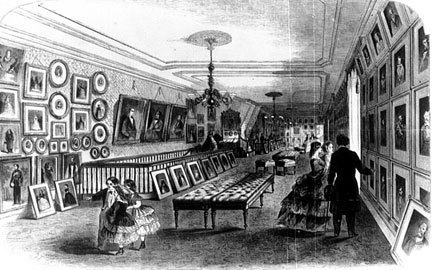 The Brady studio on Broadway, circa 1850. But Brady also had a keen sense of history in the making, and as a result managed to photograph many prominent men of the day, including every president or ex-president from John Quincy Adams to William McKinley, with the exception of William Henry Harrison, who died after only a month in office. When the Civil War broke out, Brady, known up till then chiefly for his portraits, sent out teams of photographers to document the war. Photographers of that day couldn’t catch soldiers in action, but they could photograph quiet poses of soldiers and their leaders, forts and camps and, most memorably, battlefields littered with the bodies of the dead, scenes that brought home the realities of war to the public, who up till then had known only the heroic representations of artists. Having spent over $100,000 on plates, Brady hoped the government would buy his war photographs once the war ended, but it refused to do so, forcing Brady to close his New York studio and declare bankruptcy. He finally managed to sell a large collection of negatives to the War Department and got $25,000 from Congress, but he remained heavily in debt. In 1896 he died penniless in the charity ward of a New York hospital. But thanks to him our Civil War is the first war in history to be documented in detail by photography. So ends my glance at New York shops then and now. It’s been an adventure and I’ve learned a lot. Do you have any favorite New York shops not mentioned here? If so, let me know. I may do another post on shops in the future. Coming soon: Five Steps to Sure Success for All Bunco Artists, Con Men, and Hoaxers. A look at the forgotten genius Henry T. Helmbold, king of the patent medicine men, and some “big-brained” railroad promoters who “meant business.” © 2014 Clifford Browder
The Brady studio on Broadway, circa 1850. But Brady also had a keen sense of history in the making, and as a result managed to photograph many prominent men of the day, including every president or ex-president from John Quincy Adams to William McKinley, with the exception of William Henry Harrison, who died after only a month in office. When the Civil War broke out, Brady, known up till then chiefly for his portraits, sent out teams of photographers to document the war. Photographers of that day couldn’t catch soldiers in action, but they could photograph quiet poses of soldiers and their leaders, forts and camps and, most memorably, battlefields littered with the bodies of the dead, scenes that brought home the realities of war to the public, who up till then had known only the heroic representations of artists. Having spent over $100,000 on plates, Brady hoped the government would buy his war photographs once the war ended, but it refused to do so, forcing Brady to close his New York studio and declare bankruptcy. He finally managed to sell a large collection of negatives to the War Department and got $25,000 from Congress, but he remained heavily in debt. In 1896 he died penniless in the charity ward of a New York hospital. But thanks to him our Civil War is the first war in history to be documented in detail by photography. So ends my glance at New York shops then and now. It’s been an adventure and I’ve learned a lot. Do you have any favorite New York shops not mentioned here? If so, let me know. I may do another post on shops in the future. Coming soon: Five Steps to Sure Success for All Bunco Artists, Con Men, and Hoaxers. A look at the forgotten genius Henry T. Helmbold, king of the patent medicine men, and some “big-brained” railroad promoters who “meant business.” © 2014 Clifford Browder
Published on November 23, 2014 04:15
November 16, 2014
153. New York Shops: Cupcakes, Jacaws, and Pyrenees Brebis.
Yes, cupcakes, jacaws, Pyrenees brebis, and much, much more. This came to mind recently when, on WBAI (which is currently in the throes of another of its interminable fund drives), I heard nutritionist Gary Null interrupt a spiel on health and nutrition to affirm that, in his opinion, New York City has never been a more interesting place to live in or visit than right now, because of the amazing diversity of fascinating little shops to be found here. So I began cataloguing all the little shops, past and present, that I have known, and I was amazed at their number and diversity. Hence this post.
Cupcakes? Yes, of course, right downstairs in my building, where on the ground floor the Magnolia Bakery of “Sex and the City” fame still flourishes, offering gooey goodies that multitudes flock to consume, some of them sitting on our doorstep as their greedy jaws chomp in unison – a hilarious sight to see. Having mentioned the Magnolia before, I won’t linger, but I want to report that my partner Bob and I finally, after all these years, have tasted of its viands. Janice, a kayaking nun of our acquaintance, came recently to see us and brought us two cupcakes, one vanilla and one chocolate. Bob chose the chocolate, so I consumed the vanilla and, even though I haven’t much of a sweet tooth, had to confess it was delicious. And when I asked Bob how he found the chocolate, he answered in one word: “Divine.” So the Magnolia hasn’t lost its touch. No wonder Janice is taking a bunch of cupcakes back to the Sisters of Mercy in New Jersey who, when not fending off the Vatican and performing good works, are entitled to a bit of indulgence. And what a plug for Magnolia: Even nuns adore our cupcakes! And as a further sign of the Magnolia’s raging success, I’ll add that they even sell T-shirts, jars, cookbooks, aprons, a cake knife, and eco-friendly bags.
 joe goldberg
joe goldberg WestportWiki
WestportWiki A macaw. Not the quietest of neighbors.
A macaw. Not the quietest of neighbors.Ruth Rogers Having been in the building for decades, Bob and I know of the Magnolia’s predecessors in that highly prized location on the corner of Bleecker and West 11th Street. Before the cupcakes, it was birds: macaws, parakeets, cockateels, and parrots. Run by a Wall Street insurance broker, Bird Jungle occupied the site for years and attracted a host of visitors fascinated by the birds’ gorgeous plumage and, in some cases, their ability to talk. One blue-and-gold macaw enthralled visitors with its litany of ten words in Polish, acquired from its previous owner, a Polish businessman who had to part with it when he returned to Poland. The birds chattered cheerfully during the day, but a friend who lived above the store complained that, when they were fed at 6 a.m. every morning, their chorus of squawks and shrieks and jabbering jolted him awake and cost him sleep. For Bob and me, high up on the top floor, their matutinal chitterings were muted to a soft symphony of sounds that bothered us not a whit.
And before the birds? A series of shops, most of whom I’ve forgotten. But not one: a clothing store, as I recall, that wasn’t there long. One afternoon I came home to find a cluster of police cars parked nearby. Such things happen often in the city; I shrugged and went on up to the apartment. But the next day I learned, albeit via hearsay, what had happened: the shopkeeper had hanged himself in the back of the store. Why? He had just moved there from a nearby location that had been destroyed by a fire; having no fire insurance, he had evidently succumbed to depression. And I do emphasize “evidently,” having no way of verifying. In a vast city like New York, news items that would be featured in a small town press are never reported in the papers, unless there is a neighborhood weekly on the scene. Not a cheerful memory, but one hopefully effaced by the jabbering birds, followed by the feast of cupcakes delicious and divine.
Nest door to the Magnolia is another ground-floor shop that also belongs to my building. There the turnover has been great: one shop after another, presumably because you either make it there and make it big, or the high rent drives you out. And since Marc Jacob moved in across West 11th Street, inaugurating the new phase of Bleecker Street and the invasion of pricey designer clothing stores, those high rents have skyrocketed, driving out two restaurants of our acquaintance and other humble renters as well, no doubt. So what courageous and adventurous enterprise dares to occupy 399 Bleecker Street now, in close proximity to the enduring Magnolia? The answer is Bond No. 9.
And what is Bond No. 9? Until the Sunday before last, I hadn’t the slightest idea. Coming back from lunch with our perennial Sabbath visitor, John, I happened to walk by no. 399 and observed, nicely arranged in its window, an array of small bottles identical in shape, but each one strikingly distinct. “Making scents of New York” proclaimed the logo, so I concluded – correctly, that these were perfumes. Perfumes are for me terra incognita, a vast hinterland of knowledge that I have never ventured to explore. Why, then, did I go in, knowing full well that I had no intention of buying? Probably some obscure intimation that this might be the beginning of a post on New York shops, the fact that the shop – so unlike the crowded bakery next door – was for the moment devoid of customers, and an awareness that the bottles conveyed unmistakably an impression of New York chic.
 Add caption Bond No. 9
Add caption Bond No. 9I at once identified myself as an upstairs neighbor and was greeted cordially by two sleek and chic young people, a young man with a scarf around his neck and a young woman whose dash of bold red lipstick suggested the slash of a stiletto across her face. They were most cordial and welcoming and introduced themselves by their first name. A short conversation followed, during which I mentioned my blog and the possibility of a post on shops that would certainly include Bond No. 9, in which case I would surely stick my nose in again. When I asked for a brochure or something that would identify the shop, they gave me a small circular tag proclaiming the name of the store and its motto (Making scents of New York), with the address of a series of stores on the back.
By now I was hooked enough to seek out the Bond No. 9 website, where I learned a passel of facts. “Bond No. 9,” the name of their fragrance collection, is also the address of their headquarters boutique at 9 Bond Street, Manhattan. They take pride in announcing that their perfume collection has been launched as an homage to the city of New York, and that many scents are meant to convey the essence of a New York neighborhood – certainly a novel and arresting innovation. On the website, as in the window of their Bleecker Street store, are a large number of perfumes in svelte bottles identical in shape but each with a different color: New York Sandalwood, New York Patchouli, Riverside Drive, West Side, Manhattan, and so on. So I decided to investigate So New York, a phrase I often use (“That is so New York!”), and of course Bleecker Street, which their staff whom I talked with describe as their most popular scent, while giving me a free sample on my second visit. Here's how these two perfumes are described:
So New York
A whiff of New York’s consuming passion above-all-else for chocolate desserts and frothy lattes. For sensualists of sweets, a grown-up perfume liqueur doused with bittersweet espresso and warm-milk accords, plus a hint of spice.
Bleecker Street
Art, fashion, seduction, and dessert in liquid form. A warm and sensual aphrodisiac that glides from day into evening.
But for Bleecker Street, that's just the beginning. A Bond No. 9 press release explains that they were quick to create a perfume suiting Bleecker Street, once that thoroughfare became a designer hotspot. Their scent consists of vanilla (a salute to the Magnolia cupcakes next door, but also an ingredient famed for its aphrodisiac powers), cassis, caramel, cinnamon, thyme, aromatic woods, musk (for warmth and sensuality), and patchouli (another fabled aphrodisiac). To which they add: "Spritz at your own risk, or give it to someone who knows the score." Enticing as the perfume is, this resident of Bleecker Street isn’t sure that the street itself is sensual and glides from day into evening. Nor are these scents for everyone’s budget; a 100 ml flask of Bleecker Street goes for $280.00, and a mere 50 ml flask for $205.00. But my partner Bob, much more knowledgeable about perfumes than I am, assures me that such prices are not out of line for a really fine product. So take your pick, denizens of Brooklyn, Manhattan, or wherever; there is a scent for you. And for those who don’t live in or near New York, the Bond No. 9 collection is also available in Vancouver, Montreal, Dubai, and elsewhere abroad.
Having lived on West 11th Street for decades, of course I remember Bleecker Street shops of the past, as for instance:
The Victorian jewelry shop in front of whose window I could linger for ten or fifteen minutes at a time, eyeing the lavish display of necklaces or rings or brooches, all in rare profusion. The proprietor behind the counter inside was often heard to exclaim, “You’re just the kind of customer we like. You don’t buy, you just want to look!”
The shop with fine old prints that never seemed to attract customers, presumably because of the high prices. Then once I heard, I don't know from whom, how a moneyed gent had breezed in one day, eager to find a unique Christmas gift for each of his relatives, and bought some twelve or fifteen prints, thus paying the shop’s rent and other expenses for the next three months.
The used bookstore once located where Bond No. 9 now is, with shelves and stacks of old books, and a shopkeeper who sat quietly well into the night, reading. If someone came in to browse, that was fine by him, and if no one came in, that was all right, too. If a browser bought, that was also fine; if a browser didn’t buy, that wasn’t a problem either. For him, the store was more hobby than business. But I did go in and browse once, and almost immediately found a book I desperately needed but wasn’t looking for: an English translation of Lucretius’ De rerum natura (On the Nature of Things), a philosophical opus I was trying – and I do say trying – to read in Latin. Ah, those were the days!
But this city’s fascinating little shops are by no means confined to Bleecker Street. Going to vote last Tuesday, returning along Hudson Street I found the following:
First, Spa Belles, offering manicures, waxing, facials, and more, plus the assurance that “les ongles peuvent tout avoir” (fingernails can have everything), whatever that may mean.
Next, Belly Dance, selling maternity outfits on manikins of the appropriate shape.
And finally, right next door to Belly Dance, The End of History, offering “20th century glass, ceramics, lighting, and furniture,” with a window display of lamps, ceramic vases, and a huge glass globe of the world, the prices of which, though of course not stated, would probably be the end of your budget. But there’s no denying the quality of the decorative objects on display. Their blog mentions vintage hand-blown glass and mid-century modern furniture, and provides illustrations of an Indian chair inlaid with mother of pearl, a Danish lidded jar of the 1930s with classical nudes, a mid-century bust of the Buddha from Italy, a pair of black ceramic bottles with rattan detail also from Italy, a pair of French Art Deco gilt bronze lion bookends, and countless other items.
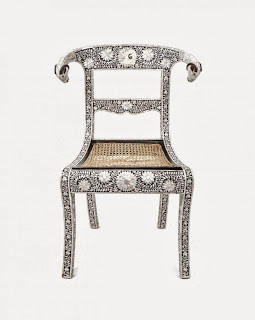 A chair from India, Regency style, inlaidwith mother of pearl, mid-20th century.The End of History
A chair from India, Regency style, inlaidwith mother of pearl, mid-20th century.The End of History
 A ceramic lidded jar with classical nudes
A ceramic lidded jar with classical nudesin Persian glaze, from the Danish studio
of Michael Andersen, 1930s.The End of History
 Black ceramic bottles with rattan detail, made in
Black ceramic bottles with rattan detail, made inItaly by the importer and distributor Raymor, 1950s.The End of History
For unusual greeting cards, you can’t do better than the House of Cards & Curiosities at 23 Eighth Avenue, which my friend John introduced me to. Besides cards, the window offers several antlered deer heads, figurines of dancing skeletons, and a facsimile of a human skeleton, suggesting that this is a very special kind of card shop. Inside you find a tiny, cluttered shop with an amazing variety of cards, some seasonal and some not, but always exceptional, devoid of clichés, at the antipodes from Hallmark cards. Yet however taken with the cards you may be, you should also glance at the shelves overhead, where you will encounter an alleged dinosaur tooth, a phrenology head, and a framed butterfly, real or fake, with wings of dazzling blue. For a friend in an upstate nursing home I picked out a card with a Japanese print of a peacock, a dazzling work of art that I knew she wouldn’t casually discard but would more likely post somewhere for all to see. But they also have Mexican Day of the Dead figures – ladies with grinning skulls and elaborate hats – and skeletal folk art from all over Latin America and Asia. And on a lighter note there are gift bags and boxes featuring Winnie the Pooh and Mickey Mouse, plus ribbons, frames, stationery, Whoopie Cushions and Cursed Cookies (whatever those may be), and even handmade papers from Tibet. And if this last isn’t exotic enough, how about some fossil ivory carvings from Bali? But if, like me, you just want some beautiful and unusual greeting cards and don't mind the cost, you’ll find plenty to choose from. And at the counter where you pay, you'll find Schadenfreude Mints, "as delicious as other people's misery."
Let’s now venture a little farther east on Bleecker Street, crossing Seventh Avenue and leaving the high-fashion, high-rent stretch of designer clothing stores behind. And so we come (or used to come) to Aphrodisia Herb Shoppe at 264 Bleecker Street, whose awning proclaimed it “an experience in herbs, spices, and essential oils.” A cat, or sometimes two cats, sprawled lazily in the window, while lining the shelves inside were large glass jars with every kind of dried herb or spice you could think of, many of them in more than one form. Sassafras, for instance, was available as bark, leaf, or tea. Once when I phoned to ask if they had vanilla, the proprietress, Joann Pelletiere, asked what kind of vanilla, since she had it in at least four forms; I explained that I wanted it in liquid form for baking, which turned out to be extract of vanilla. I used to go there periodically and select the herbs and spices I needed, putting each in a little paper bag that she would weigh at the counter and then total the cost of my purchases. In the course of my shopping I garnered whiffs of sage, rosemary, and thyme (the so-called Thanksgiving herbs), then a dash of black pepper, a rich hint of cloves. Ms. Pelletiere was a knowledgeable woman, and I once heard her say to another customer, “Well, they used to call us witches and treated us accordingly.” So she felt bonded with the Wise Ones, the women healers and midwives of centuries back, whose knowledge of healing could either enshrine them or imperil them, depending on the mood of the society they lived in.


Hearing those words, I at once thought of my friend Lilith (no, I’m not making that name up), who when her children were grown and gone embraced the profession of healing. She told me how she had gone all the way to distant Oaxaca, Mexico, to learn from a renowned Zapotec healer. Since the woman spoke no Spanish, much less English, and Lilith spoke no Spanish, at first they needed two translators; what the woman said was translated from Zapotec into Spanish, and then from Spanish into English. But after two days, Lilith said, there was such rapport between her and the healer that they dispensed with both translators. This digression takes us far from Aphrodisia, but I couldn’t resist: the tradition of women healers is alive and well today.
I regret to add that Aphrodisia, at 264 Bleecker since 1969, shut its doors earlier this year because of a drastic increase in rent. Ms. Pelletiere left a note saying that she hoped to relocate at another address, but so far that apparently hasn’t happened. So farewell, at least for now, to a memorable New York shop that was legendary in its time.
Just down the street from Aphrodisia’s location is another New York legend, Murray’s Cheese Shop at 254 Bleecker, which is still very much a going concern. I have never visited Murray’s, but a friend of mine from North Carolina recently did and showed me the exotic cheeses he had bought there, a small chunk of each, neatly wrapped. I don’t recall the names of the cheeses, but they were cheeses I had never heard of, didn’t know existed. The website offers such temptations as Vermont creamery mascarpone, bleu du bocage, cabra romero, rogue creamery smokey blue, young goat gouda, and Irish cheddar, some of them cave-aged, with color photos to whet your interest. Their cheeses come from the U.S., France, Italy, Spain, the United Kingdom, Ireland, Switzerland, the Netherlands, Germany, Austria, and Greece. And to spread the word about them, they offer classes and sponsor monthly clubs. Who could resist learning more about, and consuming, items like these (illustrations courtesy of Murray's):
 Robiola foglie di fico.
Robiola foglie di fico.
 Pyrenees brebis.
Pyrenees brebis. Goat log trio.
Goat log trio.I have vowed never to set foot on these hallowed premises, since as a vegan I can easily do without meat, but cheese is a potent temptation. But there are risks as well. Years ago a friend told me how he and some others visited a famous cheese shop – quite possibly Murray’s -- and sampled any number of cheeses; coming back on the subway, their breath so reeked of cheeses that other passengers were quick to move away from them.
A store that I have just visited for the first time is Three Lives bookstore at 154 West 10th Street, which, like all the others mentioned in this post, is within easy walking distance of my apartment. Dating from 1968, Three Lives calls itself "a haven for people who read," "an anachronism," and "the shop around the corner." Despite competition from the big chains and the Internet, Three Lives, unlike so many little bookstores, has survived, a place where the staff love to read and talk about books, and one that the Greenwich Village Historical Society has hailed as "a pocket of civility." When the current owner, Toby Cox, was asked once if there was anything new going on at Three Lives, he wrinkled up his nose and replied, "No. I guess the new thing I'm trying to do is to do nothing at all."
On the basis of my recent visit, I concur in all the above. It is a charming little store with books displayed everywhere. At first you think there is no order, but then you realize that there are sections: New York, cooking, LGBT, mysteries, travel guides. Only with great effort did I resist buying, being well aware that our apartment is overloaded with books, some of which we are determined to sell. In what must be the how-to section I saw How to Sit and How to Eat by Thich Nhat Hanh, a Zen Buddhist monk now living in France, who seems to be a master of everything. But close by were How to Be Alone and How to Deal with Adversity, right in the old American tradition of How to Win Friends and Influence People.
The book -- or rather books, since there are six of them -- that should have tempted me, but didn't, is Karl Ove Knausgaard's My Struggle, an autobiographical series of six novels about his private pleasures and dark thoughts, of which he seems to have a lot, as the series is 3,600 pages long. Since the first volume's publication in 2009, My Struggle has sold close to 500,000 copies in Norway, or one copy for every nine Norwegian adults, and has been been translated into 22 languages. A literary sensation, obviously. My partner Bob's Norwegian doctor recommended it, disclaiming any chauvinistic bias, while likening it to Proust's multivolume autobiographical epic. So why have I held back? First, the price: volumes 1 and 2, available at Three Lives, cost $16.00 each, which, if the work should grab me, would commit me to an outlay of $96.00 in all, once the other volumes appear in English. Also, 3,600 pages sound like the endeavor of a lifetime. (Which Proust's work could also be considered to be.) And the title, so reminiscent of Hitler's Mein Kampf, and even more so in Norwegian: Min Kamp. Also, the author's photograph: a hard-faced, hirsute character with a long tangle of hair who looks like he was born to brood and snarl. No wonder some of his family tried to prevent publication, protesting the book's insinuations and lies, which probably helped boost sales in Norway. And his name: Knausgaard sounds harsh and aggressive to the ear. But thanks to Three Lives this author, hitherto unknown to me, has certainly made an impression.
The catchiest title that I saw: There Once Lived a Mother Who Loved Her Children, until They Moved Back In. The lament of an American mom in the wake of the Great Recession? Not at all. Three novellas by Russian author Ludmilla Petrushevskaya, available in English translation. No question, Ms. Petrushevskaya has a knack for catchy titles; other translated works by her include There Once Lived a Girl Who Seduced Her Sister's Husband, and He Hanged Himself: Love Stories, and There Once Lived a Woman Who Tried to Kill Her Neighbor's Baby: Scary Fairy Tales. Her post-Soviet Moscow must be just as weirdly stimulating as my New York, though perhaps bleaker. These are dark tales, yet her photograph shows her to be the opposite of Knausgaard in appearance: a grandmotherly type with the nicest smile who surely wouldn't harm a fly, much less kill her neighbor's baby. And her name, once you master the pronunciation, is almost musical -- quite the opposite of Knausgaard. And she sings. Literally: she gives concerts.
Titles that sorely tempted me: Greenwich Village Stories (since I live there) and Garlic (since I use it every day), though with great effort I resisted. But I'll be back for sure, having rediscovered the joy of browsing in a real bookstore, a small one with dedicated and friendly employees, where you discover books and authors you didn't know existed. Book lovers of the world, forget about Barnes & Noble and Amazon and head for Three Lives; you will be cordially and comfortably received.
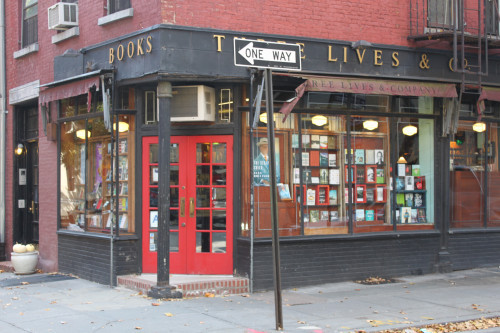

Coming soon: More shops, some of them naughty or illicit: West 4thStreet Shops: Bongs, Gongs, and Thongs, plus a Killing.
© 2014 Clifford Browder
Published on November 16, 2014 04:51
November 9, 2014
152. Advertising: Ridiculous, Annoying, Despicable, and Fun
Obviously, given the history of nineteenth-century patent medicines (see the previous post), twentieth-century advertisers were far from pioneering the adventurous, the vexing, and the blatant in advertising. By comparison with their predecessors, they were discreet, restrained, and subtle. But they did turn advertising into a major industry with finely crafted messages designed to reach mass audiences, and by the 1920s were so concentrated on Madison Avenue in Manhattan that the name of the avenue (often facetiously shortened to “Mad Avenue”) became synonymous with the industry. Today, many agencies have relocated elsewhere in Manhattan, but the name “Madison Avenue” designating the industry persists.
One thing these agencies have labored to perfect is the magical phrase, words that sing, the lightning phrase that will burn its way into the brains of consumers. And they often succeed, as witnessed by these that I remember, many from long go, all too readily:
· Prevents halitosis. (Don’t remember the product.)· 99 and 44/100% pure; it floats. (Ivory soap)· Ipana for the smile of beauty and Sal Hepatica for the smile of health.· (sung) Don’t despair, use your head, save your hair, use Fitch Shampoo.· I’d walk a mile for a Camel.· Modess … because.· Good to the last drop. (Maxwell House Coffee)
 It was floating even in 1898, during
It was floating even in 1898, duringthe Alaska gold rush.
Adam Cuerden
 A Camel ad from 1915. I remember the same
A Camel ad from 1915. I remember the samepicture of a camel from the 1930s.
And they even appeared abroad. In 1952, at the one movie theater in Besançon, France, where short ads appeared on the screen before the featured film, I recall a series of rather entertaining shorts that ended with
Dents blanches, haleine fraïcheSuperdentifrice Colgate[White teeth, fresh breathSupertoothpaste Colgate]
I classify ads in four groups:
1. Ridiculous2. Annoying3. Despicable4. Fun
1. Ridiculous:
· Why not get your novel produced as a motion picture? · The Writer’s Hypnotherapist/End writer’s block. Develop your voice.· 48 Hour Books
All the above from Poets & Writers, July/August 2014. What easy marks aspiring writers must be! But also, probably from the New York Times, though I’m not sure, and dating from the 1960s:
· WE HAVE 560,000 NAMES WITH COATS OF ARMS.(HERE ARE JUST A FEW)[Some 600 common last names are listed.]IS YOUR NAME LISTED HERE?THE CHANCES ARE 98% IN YOUR FAVORTHAT WE WILL BE ABLE TO RESEARCH AND FIND A COAT OF ARMS BEARING YOUR NAMEIF YOUR ANCESTORS CAME FROM ANY OF THESE COUNTRIES[All European countries plus Iceland are listed.]GET A DOCUMENTED COAT OF ARMS ON YOUR CHECKSAVAILABLE ONLY ATFRANKLIN NATIONAL BANK
2. Annoying:
· Your best friends won’t tell you. (B.O., Lifebuoy soap)
· Your golden liver bile. (I used to hear it on the radio just as I was starting lunch. Don’t remember the product.)
· Tu es un homme! [You are a man! Va en Indochine Go to Indochina te battre pour la liberté. to fight for freedom. Tu deviendras un chef! You’ll become a leader!]
Posted outside a shabby little Foreign Legion recruiting station in Lyons, France, in 1963, when the French were losing their war in Indochina, and we had yet to intervene. Inside, a Legionnaire sat at a table reading something. No takers; he looked bored. Annoying, but also ridiculous.
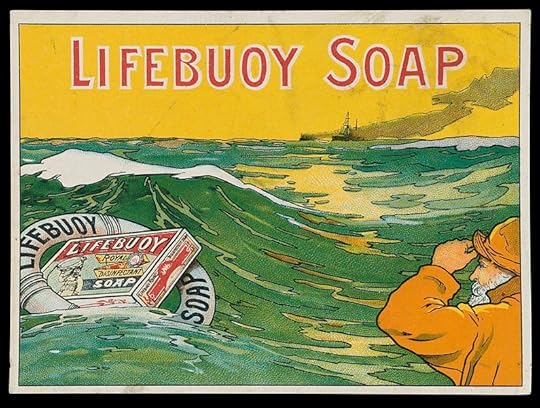 An old Lifebuoy ad, date uncertain. No B.O.mentioned, but it too floats.
An old Lifebuoy ad, date uncertain. No B.O.mentioned, but it too floats.Wellcome Images
3. Despicable:
All cigarette ads, given what we now know about the cigarette companies.
In the Times of February 19, 1967, a warning in bold print about The Counterfeit Executive, a glib, intelligent, and persuasive employee who will produce little and destroy more. The solution? The stress interview, a grueling technique to discover the counterfeit, the misfit, the "special problem" executive. Conducted by Einstein Associates, executive search consultants.
And now the most despicable of all: Five college girls sitting together in a dorm. They’re talking about their fathers. Girl #1: "My father is head of a bank." Girl #2: "My father runs his own business." Girl #3: "My father is a judge." Girl #4: "My father is a professor." To girl #5: "What does your father do?" Girl #5: "He's just sweetest old Dad that ever was!"
Followed by the pitch for a self-improvement program, so your children won't be ashamed of you years hence. (Imperfectly but distinctly remembered from a 1920s National Geographic that a friend once showed me.)
Finally, an ad from I don’t know what publication that haunted me, naïf that I was, in the 1940s. Hard to classify. Ridiculous? Annoying? Truly offensive? Interesting, in any event, given its subtle – or not so subtle – dose of male eroticism.
“ ‘We’d rather paddle freshmen who squirm!’ ”
[Illustration of a college locker room or dormitory where a freshman in his underwear is being paddled by a crowd of laughing and jeering young men, one of them also in his underwear.]
Both brothers and hazers stoutly affirm“We’d rather paddle freshmen who squirm!”
Take a Complete JockeyUnderwardrobe to School
Smaller print explains that practically everybody wears Jockey, so if you don’t want to look conspicuous and attract unwanted attention, you’d better wear Jockey, too. And of course you won’t squirm.
5. Fun:
· Times Square at night with all those illuminated ads: fun, interesting, and just plain overwhelming.
· Travel ads, even if they pretty things up a bit.
· You don’t have to be Jewish to love Levy’s. Levy’s Jewish Rye
With a picture of a native American munching the bread with a look of obvious delight. It might not fly today, but back in the 1960s it seemed genuinely funny. Other versions included an Irish cop, a black kid, a Chinaman.
· 20 Mule Team Borax
With a picture of a laden wagon pulled by 20 teams of mules. Appearing on boxes of the product, the picture fascinated me, history buff that I was. And on the radio program Death Valley Days, telling stories of the Old West, the voice of the Old Ranger, who sounded authentic as hell, told how the mineral boron, used in the Pacific Coast Borax Company’s cleaning agent 20 Mule Team Borax, was once extracted from deposits in Death Valley, California, and transported by mule team to the nearest railroad.
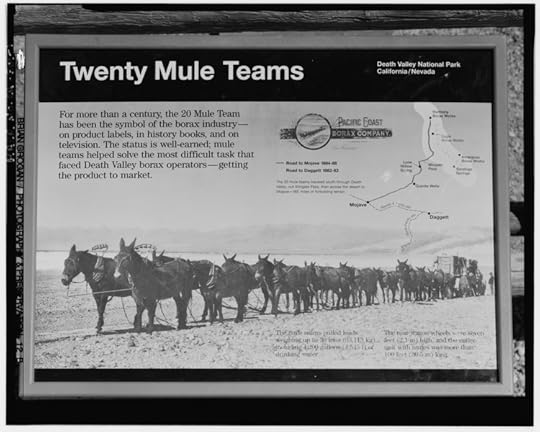 The 20 mule teams really did exist in Death Valley, as this picture shows.
The 20 mule teams really did exist in Death Valley, as this picture shows.· Maxwell House Coffee
It wasn’t drunk in our house, but I heard commercials on the radio telling how the coffee had first been served in the old Maxwell House Hotel in Nashville, Tennessee (which was true enough). Definitely a soft sell, it created the image of gracious living with elegant diners in an elegant old hostelry sipping a delicious coffee. Again, my fascination with history may have sparked my interest.
 A 1921 ad. No Maxwell House Hotel in sight, but still
A 1921 ad. No Maxwell House Hotel in sight, but stillgood to the last drop.
Depending on their product and their target audience, advertisers used either a hard sell or a soft sell. As for instance:
Hard sell: BUY! BUY! BUY!
Soft sell: Please …
And for an example of hard sell, how about this full-page ad from the financial section of the Times of October 30, which I can only partially and crudely suggest:
GOLD SALE!Take Advantage of Gold’s Best Price in Years!36% LOWERthan record high gold prices. Do not miss this opportunity!SPECIAL ROCK-BOTTOM PRICING$134per gold coin. Maximum of 10 coins.Call Now!
One can well ask: are advertisers hucksters or communicators? Much of the preceding would suggest hucksters, but one of my uncles, who headed his own ad agency and ended up the grand old man of advertising in Indianapolis, explained advertising in a very reasonable way: “Industry makes things, but it doesn’t know how to sell them. That’s where advertising comes in.” I visited his agency once and talked to a copywriter who disabused me of any stereotypical image of his profession by explaining that his only lubricant was an occasional sip of orange juice from a container stashed on his windowsill; not for him the three-martini lunch. My other recollection: the front-desk receptionist, a very attractive young woman dressed to the nines, making the very important first impression that a caller would receive of the agency. I might add that my uncle’s clients made products that struck me as uncontroversial and eminently useful, reinforcing his argument for advertising as communication.
His daughter Virginia, my cousin, had a somewhat different take on advertising. A veteran of the industry in both New York and Chicago, she said once of her top boss in Chicago, “He’ll go far. He has larceny in his heart.” That for her was the key to success in advertising, at least in New York and Chicago.
Virginia had worked for years in advertising in New York, a city that she loved, but finally she moved to Chicago. Her complaints about New York in the 1940s and 1950s:
· Reasonably priced housing only in slummy neighborhoods.· A long commute from her apartment to work.· Always having to stand on the subway trains going to and from work.· In every agency where she worked, another woman obviously making a lifelong career in advertising. Since in those days most agencies had room for only one such woman, that meant competition.
In Chicago, on the other hand, there were many advantages:
· A nice apartment in a nice neighborhood with a reasonable rent.· A mere twenty-minute commute to the Loop.· Always getting a seat on the L going to work. · Being the only career-oriented woman in the agency.
She liked Chicago, but she loved New York. Just walking down the street in New York was exhilarating; it thrilled her just to be a part of the city. Good as Chicago was, she never quite got that feeling there.
What are your most memorable, or most objectionable, ads? Let me know, if you have any.
Coming soon: New York shops: cupcakes, jacaws, a sensual aphrodisiac, cards with skulls, young goat gouda, and much else.
© 2014 Clifford Browder
Published on November 09, 2014 05:33
November 1, 2014
151. Advertising: Hucksters of Yore and Today
Last Monday it began when I checked my e-mail and found two bits of spam, one urging Viagra on me and the other, Rolex watches. I clicked them off.
Next, in a doctor’s office, as I was leafing through one of the stupid magazines always found in doctors’ offices, I came upon a plea for a topical solution to treat onychomycosis. Onychomycosis? Had I not been a seasoned skeptic, I might have been gripped with fear. Small print explained: toenail fungus.
Then, as I glanced at the New York Times (“All the News That’s Fit to Print”) over lunch, I was assaulted on every other page:
CHANEL‘Boy Chanel’ bag with stitched chain detail, $6,100
BrequetDepuis 1775Reine de Naples CollectionIN EVERY WOMAN IS A QUEEN
WHAT THE WORLD NEEDS NOW ISSIMPLE
Push your enterpriseand move the world.hpMake it matter.
COPD Kills One Person Every Ten Seconds Worldwide.Learn the Complete Cure Now!
Know-hows of Dr. Seo-Hyo-seok, Author of <Free from Chemical Medicine>, and His Forty One Years of Eradicating COPD!
And all these in that fortress of sobriety, the Times!
Throughout the day the phone rang with recorded messages:
· “Hello, this is Bridget. I want to …” I hung up.· “Did you know that sixty-five percent of seniors …” I hung up.· “Congratulations! You have been chosen …” I hung up.
Yes, we are bombarded every day by hucksters. They try to frighten us, entice us, inflate our dreams, prod us into action. God knows, there’s enough to frighten us:
· baldness· erectile dysfunction· depression· the end of democracy as we know it· constipation· bad breath· global warming· 5 o’clock shadow· B.O.
But they also promise us
· wealth· health· glamor· sex appeal· security· success
And let’s face it, we wouldn’t mind having all of them, and more.
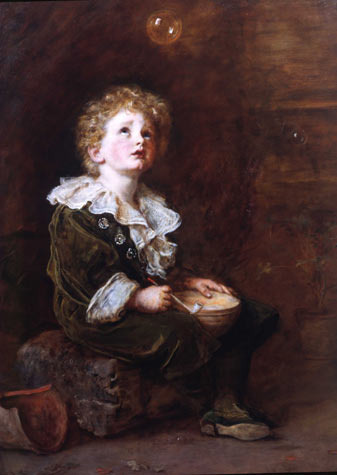 Millais, Bubbles, 1886. As I know from a trip long ago to Europe, foreigners blame us for these assaults. True enough, in many ways, but modern advertising is not the invention of American advertisers. The man hailed as “the father of modern advertising” was in fact an Englishman, Thomas J. Barratt (1841-1914), who as chairman of the soap manufacturer A&F Pears pioneered what is now known as brand marketing. “Good morning. Have you used Pears’ soap?” was his slogan, a catch phrase that was famous well into the twentieth century. He got a testimonial praising Pears soap from actress Lillie Langtry, a reigning beauty known for her matchless complexion, which was the first celebrity testimonial in advertising history. Ruthlessly inventive, he turned John Everett Millais’ painting Bubbles, showing an adorable little boy with golden curls blowing a bubble, into an advertisement by adding a bar of Pears’ soap in the foreground. Millais is said to have protested this, but Barratt had bought the painting and therefore owned the copyright. This was not the last use by far of the image of an adorable child to market products successfully; nineteenth-century advertising was big on childhood innocence, the more sweet-faced the better.
Millais, Bubbles, 1886. As I know from a trip long ago to Europe, foreigners blame us for these assaults. True enough, in many ways, but modern advertising is not the invention of American advertisers. The man hailed as “the father of modern advertising” was in fact an Englishman, Thomas J. Barratt (1841-1914), who as chairman of the soap manufacturer A&F Pears pioneered what is now known as brand marketing. “Good morning. Have you used Pears’ soap?” was his slogan, a catch phrase that was famous well into the twentieth century. He got a testimonial praising Pears soap from actress Lillie Langtry, a reigning beauty known for her matchless complexion, which was the first celebrity testimonial in advertising history. Ruthlessly inventive, he turned John Everett Millais’ painting Bubbles, showing an adorable little boy with golden curls blowing a bubble, into an advertisement by adding a bar of Pears’ soap in the foreground. Millais is said to have protested this, but Barratt had bought the painting and therefore owned the copyright. This was not the last use by far of the image of an adorable child to market products successfully; nineteenth-century advertising was big on childhood innocence, the more sweet-faced the better. On the radio you heard bellhop Johnny's
On the radio you heard bellhop Johnny'sresonant call, "Call for Phillip Morris!"
Alexisrael Modern American advertising is often associated with promotions by the big American tobacco companies in the 1920s, but it was in fact well under way in New York, among other cities, by the mid-1860s, well before Mr. Barratt and his soap. The word SOZODONT was blazoned all over the city, baffling many at first, until its purpose was at last revealed:
FRAGRANTSOZODONT,FORCleansing, Beautifying and PreservingTHE TEETHFrom youth to old age.SOLD EVERYWHERE.
But this was nothing, compared to posters and certain pages in the newspapers throughout the century featuring such products as
Swaim’s PanaceaWm Radam’s Microbe KillerHolloway’s Pills and Ointment Viner’s VermifugeDr. Girard’s Ginger BrandyDalley’s Magical Pain ExtractorDr. Lin’s Celestial Balm of ChinaPastor Koenig’s Nerve TonicPink Pills for Pale People
The secret of the success of some of these nostrums is revealed in the formula of Hofstetter’s Bitters, advertised as a cure for many ills: 4% herbal oils and extracts, 64% water, 32% alcohol. That 32% was much in demand in communities that had embraced temperance by law.
In an age when mainstream medicine had but few sound remedies – quinine for malaria, a vaccine for smallpox, and little else – the nostrums of the patent medicine men had wide appeal, all the more so in the absence of government regulations. Whatever ills the public suffered from, “certain delicate diseases” (V.D.) and “self-abuse” included, the advertisers promised marvelous results. The nostrums were sold in every conceivable kind of bottle: square, round, drum-shaped, pig-shaped, fish-shaped, in the likeness of an Indian maiden or even the bust of Washington. Manufacturers hoped they would end up as adornments (and perennial ads) on parlor mantels and whatnots, but many were smashed to pieces by imbibers fearful lest their secret tippling be discovered.
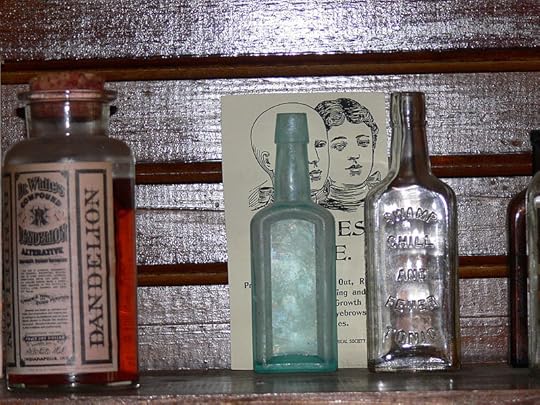 Patent medicines on a shelf in a general store today.
Patent medicines on a shelf in a general store today.Wolfgang Sauber
(Why the name “patent medicines,” by the way, when they were definitely not patented? Because, in seventeenth-century England, elixirs that found royal favor received letters patent letting them use the royal endorsement in marketing. Nostrum makers generally avoided patenting their products, because to do so would have meant revealing their ingredients; they no more wanted to do that than Coca-Cola and Pepsi do today.)
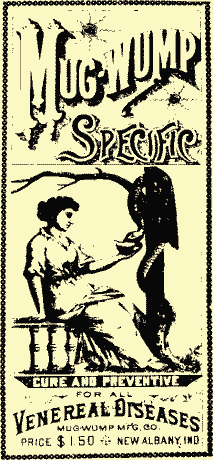 Here the near forbidden words
Here the near forbidden words"venereal diseases" are
actually stated.
Patent medicine almanacs were dispensed free on the counters of drugstores and general stores between Christmas and New Year’s, or were distributed to the public by young boys paid a quarter a day. And the names of the products appeared in posters on walls and fences and the decks and cabins of steamboats; on the sides of horsecars; on signs on wagons roaming the busy streets; on brick piles; on asbestos curtains in theaters; and on mirrors in public waiting rooms. No flat surface was safe, and the sidewalks of busy Broadway were enlivened by sandwich men flaunting the names of remedies fore and aft:
Pocahontas BittersRadical Cure TrussesPhilipot’s Infallible Extract
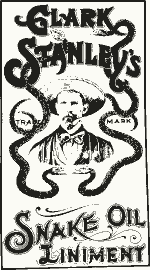 Yes, back then snake oil
Yes, back then snake oilreally did exist.
Nor was rural America spared: the names of nostrums appeared on rocks, trees, fences, barns, and sheds; adorned the soaring basalt cliffs of the Palisades, visible to passengers on Hudson River steamboats; and with the completion of the first transcontinental railroad in 1869, graced telegraph poles and even the soaring Rocky Mountains, and the Sierra Nevada range in distant California. And as a traveler approached San Francisco by train, he was informed that “VINEGAR BITTERS IS ALL THE GO FOR LOVE!” “Ob-scenery!” protested the New York Tribune, but to no avail. The ultimate in advertising was achieved when a nostrum maker bought a steamboat, adorned it with ads for his liniment, cast it adrift on Lake Erie and let it float to destruction over Niagara Falls.
Most of the patent medicine men were indeed men, but one notable exception was Lydia Pinkham, a Massachusetts housewife who, like many women of the day, brewed a home remedy for “female complaints” and gave it away free to her neighbors. In 1875, with the family’s fortunes at low ebb, one of her grown sons suggested making a business of the family remedy. Composed of five herbs and some alcohol, it was immediately successful, and production was transferred from Lydia’s stove at home to a factory. Her skill in marketing to women made Lydia E. Pinkham’s Vegetable Compound, with her features on the label, one of the most popular nostrums of the time, a modified version of which is still available today. Eager for relief from menstrual and menopausal symptoms, vast numbers of women wrote to her, and she dutifully answered them, even after her death, since her staff filled in for her, until a photo of her tombstone in the Ladies’ Home Journal in 1905 exposed the ruse. The Pinkham company then explained – somewhat lamely – that they never meant to suggest that Lydia herself was answering the letters, which were being answered by her daughter. Today Lydia is hailed by feminists as an early crusader for women’s health at a time when women’s health issues were ill served by the male-dominated medical establishment. Her descendants operate a clinic bearing her name in Salem, Massachusetts, to offer health services to young mothers and their children.
 Circa 1875, but still on the market today. And
Circa 1875, but still on the market today. Andback then she didn't have to look glamorous.
Muckraker journalists’ exposés of the patent medicine industry led to the first Pure Food and Drug Act of 1906, which required that ingredients be labeled, and a revised statute of 1936 that banned alcohol, narcotics, and stimulants altogether, following which the patent medicine makers shifted their attention to marketing deodorants, toothpastes, and shampoos. Today herbal concoctions promoted as nutritional supplements raise similar issues as the earlier nostrums once did regarding exaggerated claims, even though today’s claims are carefully phrased to avoid attracting the attention of regulators.
Clearly, the full-page ad in the Times promoting a complete cure for COPD, cited earlier, is right in the tradition of nineteenth-century patent medicines. The techniques of the nostrum makers are with us to this day. And what, by the way, is this mysterious COPD that poses such a threat to our health? Chronic obstructive pulmonary disease, which, according to Dr. Seo Hyo-seok’s ad, is the fourth leading cause of death in the world, predicted to become the third in 2030. A quick bit of online research confirms the existence of COPD, which includes both chronic bronchitis and emphysema. Further research confirms that Dr. Seo Hyo-seok is a Korean doctor who, using only Korean medicine, claims to have cured thousands of patients. Whatever their style of advertising, I don’t dismiss unorthodox medical approaches out of hand, and the conditions he is treating are for real, and life-threatening as well. So if you have lungs, watch out!
Coming soon: Advertising: Ads Ridiculous, Annoying, Despicable, and Fun.
© 2014 Clifford Browder
Published on November 01, 2014 08:04



